Friday, March 16, 2007
"Geometry,
Theology,
and Politics:
Context and Consequences of
the Hobbes-Wallis Dispute" (
pdf)
Excerpt:
"We are left to conclude that there was something significant in Hobbes's philosophy that motivated Wallis to engage in the lengthy and vitriolic denunciation of all things Hobbesian.
In point of fact, Wallis made no great secret of his motivations for attacking Hobbes's geometry, and the presence of theological and political motives is well attested in a 1659 letter to Huygens. He wrote:
But regarding the very harsh diatribe against Hobbes, the necessity of the case, and not my manners, led to it. For you see, as I believe, from other of my writings how peacefully I can differ with others and bear those with whom I differ. But this was provoked by our Leviathan (as can be easily gathered fro his other writings, principally those in English), when he attacks with all his might and destroys our universities (and not only ours, but all, both old and new), and especially the clergy and all institutions and all religion. As if the Christian world knew nothing sound or nothing that was not ridiculous in philosophy or religion; and as if it has not understood religion because it does not understand philosophy, nor philosophy because it does not understand mathematics. And so it seemed necessary that now some mathematician, proceeding in the opposite direction, should show how little he understand this mathematics (from which he takes his courage). Nor should we be deterred from this by his arrogance, which we know will vomit poison and filth against us. (Wallis to Huygens, 11 January, 1659; Huygens 1888-1950,* 2: 296-7)
The threats that Hobbes supposedly posed to the universities, the clergy, and all religion are a consequence of his political and theological doctrines. Hobbes's political theory requires that the power of the civil sovereign be absolute and undivided. As a consequence, such institutions as universities and the clergy must submit to the dictates of the sovereign in all matters. This extends, ironically enough, to geometry, since Hobbes notoriously claimed that the sovereign could ban the teaching of the subject and order 'the burning of all books of Geometry' if he should judge geometric principles 'a thing contrary to [his] right of dominion, or to the interest of men that have dominion' (Leviathan (1651) 1.11, 50; English Works** 3: 91). In the area of church government, Hobbes's doctrines are a decisive rejection of the claims of Presbyterianism, which holds that questions of theological doctrine is [sic] to be decided by the elders of the church– the presbytery– without reference to the claims of the sovereign. As a Presbyterian minister, a doctor of divinity, and professor of geometry at Oxford, Wallis found abundant reason to reject this political theory."
* Huygens, Christiaan. 1888-1950. Les oeuvres complètes de Chrisiaan Huygens. Ed. La Société Hollandaise des Sciences. 22 vols. The Hague: Martinus Nijhoff.
** Hobbes, Thomas. [1839-45] 1966. The English Works of Thomas Hobbes of Malmesbury, now First Collected and Edited by Sir William Molesworth. Edited by William Molesworth. 11 vols. Reprint. Aalen, Germany: Scientia Verlag.
Related material:
"But what is it?"
Calvin demanded.
"We know that it's evil,
but what is it?"
"Yyouu hhave ssaidd itt!"
Mrs. Which's voice rang out.
"Itt iss Eevill. Itt iss thee
Ppowers of Ddarrkknesss!"
— A Wrinkle in Time

"After A Wrinkle in Time was finally published, it was pointed out to me that the villain, a naked disembodied brain, was called 'It' because It stands for Intellectual truth as opposed to a truth which involves the whole of us, heart as well as mind. That acronym had never occurred to me. I chose the name It intuitively, because an IT does not have a heart or soul. And I did not understand consciously at the time of writing that the intellect, when it is not informed by the heart, is evil."
See also
"Darkness Visible"
in
ART WARS.
Saturday, March 10, 2007
The Logic of Dreams
From A Beautiful Mind–
“How could you,” began Mackey, “how could you, a mathematician, a man devoted to reason and logical proof…how could you believe that extraterrestrials are sending you messages? How could you believe that you are being recruited by aliens from outer space to save the world? How could you…?”
Nash looked up at last and fixed Mackey with an unblinking stare as cool and dispassionate as that of any bird or snake. “Because,” Nash said slowly in his soft, reasonable southern drawl, as if talking to himself, “the ideas I had about supernatural beings came to me the same way that my mathematical ideas did. So I took them seriously.”
Ideas:

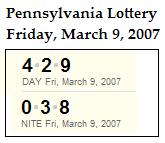
These numbers may, in the mad way so well portrayed by Sylvia Nasar in the above book, be regarded as telling a story… a story that should, of course, not be taken too seriously.
Friday’s New York numbers (midday 214, evening 711) suggest the dates
2/14 and
7/11. Clicking on these dates will lead the reader to Log24 entries featuring, among others, T. S. Eliot and Stephen King– two authors not unacquainted with the bizarre logic of dreams.
A link in the 7/11 entry leads to a remark of Noel Gray on Plato’s Meno and “graphic austerity as the tool to bring to the surface, literally and figuratively, the inherent presence of geometry in the mind of the slave.”
Also Friday: an example of graphic austerity– indeed, Gray graphic austerity– in Log24:

This illustration refers to chess rather than to geometry, and to the mind of an addict rather than to that of a slave, but chess and geometry, like addiction and slavery, are not unrelated.
Friday’s Pennsylvania numbers, midday 429 and evening 038, suggest that the story includes, appropriately enough in view of the above
Beautiful Mind excerpt, Mackey himself. The midday number suggests the date
4/29, which at Log24 leads to
an entry in memory of Mackey.
(Related material: the Harvard Gazette of April 6, 2006, “Mathematician George W. Mackey, 90: Obituary“– “A memorial service will be held at Harvard’s Memorial Church on April 29 at 2 p.m.“)
Friday’s Pennsylvania evening number 038 tells two other parts of the story involving Mackey…
As Mackey himself might hope, the number may be regarded as a reference to the 38 impressive pages of Varadarajan’s “Mackey Memorial Lecture” (pdf).
More in the spirit of Nash, 38 may also be taken as a reference to Harvard’s old postal address, Cambridge 38, and to the year, 1938, that Mackey entered graduate study at Harvard, having completed his undergraduate studies at what is now Rice University.
Returning to the concept of graphic austerity, we may further simplify the already abstract chessboard figure above to obtain an illustration that has been called both “the field of reason” and “the Garden of Apollo” by an architect, John Outram, discussing his work at Mackey’s undergraduate alma mater:

Let us hope that Mackey,
a devotee of reason,
is now enjoying the company
of Apollo rather than that of
Tom O’Bedlam:

For John Nash on his birthday:
I know more than Apollo,
For oft when he lies sleeping
I see the stars at mortal wars
In the wounded welkin weeping.
— Tom O’Bedlam’s Song
Comments Off on Saturday March 10, 2007
Comments Off on Saturday March 10, 2007
Thursday, March 8, 2007
Comments Off on Thursday March 8, 2007
Dia de la
Mujer Trabajadora

“Yo es que nací un 8 de marzo,
Día de la Mujer Trabajadora,
y no he hecho más que
trabajar toda mi vida.”
— Josefina Aldecoa
For background on Aldecoa,
see a paper (pdf) by
Sara Brenneis:
“Josefina Aldecoa intertwines
history, collective memory
and individual testimony in her
historical memory trilogy…”
HISTORICAL MEMORY–
History:
The Triangle Shirtwaist Factory Fire in New York City on March 25, 1911, was the largest industrial disaster in the history of the city of New York, causing the death of 146 garment workers who either died in the fire or jumped to their deaths.
Propaganda, March 1977:
“On March 8, 1908, after the death of 128 women trapped in a fire at the Triangle Shirtwaist Factory in New York City, 15,000 women workers from the garment and textile industry marched echoing the demands of their sisters 50 years earlier…”
Propaganda, March 2006:
“First of all, on March 8th, 1857, a large number of factory workers in the United States took to the streets to demand their economic and political rights. The owners called the police who arrived immediately and opened fire, engaging in blind repression… Later on, in 1908, the same date of March 8th was once again a memorable date of struggle. On this day, capitalist bosses in Chicago set fire to a textile factory where over a thousand women worked. A very large number was terribly burnt. 120 died!”
Propaganda disguised as news, March 2007:
From today’s top story in 24 HoursTM, a commuter daily in Vancouver published by Sun Media Corporation:
Fight still on for equality
By Robyn Stubbs and Carly Krug
“International Women’s Day commemorates a march by female garment workers protesting low wages, 12-hour workdays and bad working conditions in New York City on March 8, 1857.
Then in 1908, after 128 women were trapped and killed in a fire at a New York City garment and textile factory, 15,000 women workers again took their protests to the street.”
Related historical fiction:
A version of the
I Ching’s Hexagram 19:
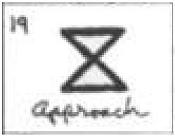
Log24 12/3/05:

— Katherine Neville, The Eight
|
“What does this have to do with why we’re here?” “I saw it in a chess book Mordecai showed me. The most ancient chess service ever discovered was found at the palace of King Minos on Crete– the place where the famous Labyrinth was built, named after this sacred axe. The chess service dates to 2000 B.C. It was made of gold and silver and jewels…. And in the center was carved a labrys.” … “But I thought chess wasn’t even invented until six or seven hundred A.D.,” I added. “They always say it came from Persia or India. How could this Minoan chess service be so old?” “Mordecai’s written a lot himself on the history of chess,” said Lily…. “He thinks that chess set in Crete was designed by the same guy who built the Labyrinth– the sculptor Daedalus….” Now things were beginning to click into place…. “Why was this axe carved on the chessboard?” I asked Lily, knowing the answer in my heart before she spoke. “What did Mordecai say was the connection?”…. “That’s what it’s all about,” she said quietly. “To kill the King.” The sacred axe was used to kill the King. The ritual had been the same since the beginning of time. The game of chess was merely a reenactment. Why hadn’t I recognized it before?
|
Perhaps at the center of
Aldecoa’s labyrinth lurk the
capitalist bosses from Chicago
who, some say, set fire
to a textile factory
on this date in 1908.
For a Freudian perspective
on the above passage,
see yesterday’s entry
In the Labyrinth of Time,
with its link to
John Irwin‘s essay
“The False Artaxerxes:
Borges and the
Dream of Chess.”

Symbols
S. H. Cullinane
March 7, 2007
Today, by the way, is the
feast of a chess saint.
Comments Off on Thursday March 8, 2007
Wednesday, March 7, 2007
Footprints for
Baudrillard

"Was there really a cherubim
waiting at the star-watching rock…?
Was he real?
What is real?
— Madeleine L'Engle, A Wind in the Door,
Farrar, Straus and Giroux, 1973,
conclusion of Chapter Three,
"The Man in the Night"
"Oh, Euclid, I suppose."
— Madeleine L'Engle, A Wrinkle in Time,
Farrar, Straus and Giroux, 1962,
conclusion of Chapter Five,
"The Tesseract"
In memory of the French philosopher Jean Baudrillard, who died yesterday, Tuesday, March 6, 2007.
The following Xanga footprints may be regarded as illustrating Log24 remarks of Dec. 10, 2006 on the Library of Congress, geometry, and bullshit, as well as remarks of Aug. 28, 2006 on the temporal, the eternal, and St. Augustine.
From the District of Columbia–
Xanga footprints in reverse
chronological order from
the noon hour on Tuesday,
March 6, 2007, the date
of Baudrillard's death:
Comments Off on Wednesday March 7, 2007
Comments Off on Wednesday March 7, 2007
Thursday, March 1, 2007
Senior Honors
From the obituary in today's New York Times of historian Arthur M. Schlesinger Jr.–
"Mr. Schlesinger, partly through his appreciation of history, fully realized his good fortune. 'I have lived through interesting times and had the luck of knowing some interesting people,' he wrote.
A huge part of his luck was his father, who guided much of his early research, and even suggested the topic for his [Harvard] senior honors: Orestes A. Brownson, a 19th-century journalist, novelist and theologian. It was published by Little, Brown in 1938 as 'Orestes A. Brownson: A Pilgrim's Progress.'"
— Douglas Martin
From The Catholic Encyclopedia:
"It is sufficient for true knowledge that it affirm as real that which is truly real."
— Article on Ontologism
From The Diamond Theory of Truth:
"Was there really a cherubim waiting at the star-watching rock…?
Was he real?
What is real?
— Madeleine L'Engle, A Wind in the Door, Farrar, Straus and Giroux, 1973, conclusion of Chapter Three, "The Man in the Night"
"Oh, Euclid, I suppose."
— Madeleine L'Engle, A Wrinkle in Time, Farrar, Straus and Giroux, 1962, conclusion of Chapter Five, "The Tesseract"
Related material: Yesterday's first annual "Tell Your Story Day" at Harvard and yesterday's entry on Euclid.
Comments Off on Thursday March 1, 2007
Wednesday, February 28, 2007
Elements
of Geometry
The title of Euclid’s Elements is, in Greek, Stoicheia.
From Lectures on the Science of Language,
by Max Muller, fellow of All Souls College, Oxford.
New York: Charles Scribner’s Sons, 1890, pp. 88-90 –
Stoicheia
“The question is, why were the elements, or the component primary parts of things, called stoicheia by the Greeks? It is a word which has had a long history, and has passed from Greece to almost every part of the civilized world, and deserves, therefore, some attention at the hand of the etymological genealogist.
Stoichos, from which stoicheion, means a row or file, like stix and stiches in Homer. The suffix eios is the same as the Latin eius, and expresses what belongs to or has the quality of something. Therefore, as stoichos means a row, stoicheion would be what belongs to or constitutes a row….
Hence stoichos presupposes a root stich, and this root would account in Greek for the following derivations:–
- stix, gen. stichos, a row, a line of soldiers
- stichos, a row, a line; distich, a couplet
- steicho, estichon, to march in order, step by step; to mount
- stoichos, a row, a file; stoichein, to march in a line
In German, the same root yields steigen, to step, to mount, and in Sanskrit we find stigh, to mount….
Stoicheia are the degrees or steps from one end to the other, the constituent parts of a whole, forming a complete series, whether as hours, or letters, or numbers, or parts of speech, or physical elements, provided always that such elements are held together by a systematic order.”
Comments Off on Wednesday February 28, 2007
Tuesday, February 27, 2007
Related material:
” … an alphabet
By which to spell out holy doom and end,
A bee for the remembering of happiness.”
— Wallace Stevens,
“The Owl in the Sarcophagus”
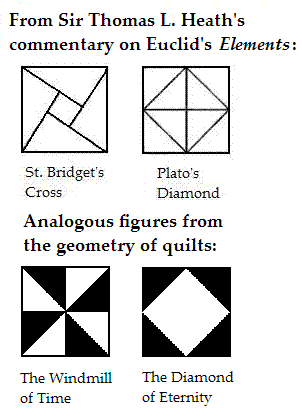
Some context for these figures:
The Diamond Theory of Truth
Comments Off on Tuesday February 27, 2007
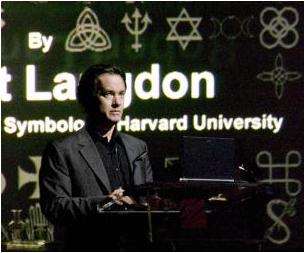
New York State Lottery
yesterday, Feb. 26, 2007:
Mid-day 206
Evening 888
For more on the artistic
significance of 206,
see 2/06.
For more on the artistic
significance of 888, see
St. Bonaventure on the
Trinity at math16.com.
A trinity:

Click on picture for further details.
Comments Off on Tuesday February 27, 2007
Tuesday, February 20, 2007
Symmetry
Today is the 21st birthday of my note “The Relativity Problem in Finite Geometry.”
Some relevant quotations:
“This is the relativity problem: to fix objectively a class of equivalent coordinatizations and to ascertain the group of transformations S mediating between them.”
— Hermann Weyl, The Classical Groups, Princeton University Press, 1946, p. 16
Describing the branch of mathematics known as Galois theory, Weyl says that it
“… is nothing else but the relativity theory for the set Sigma, a set which, by its discrete and finite character, is conceptually so much simpler than the infinite set of points in space or space-time dealt with by ordinary relativity theory.”
— Weyl, Symmetry, Princeton University Press, 1952, p. 138
Weyl’s set Sigma is a finite set of complex numbers. Some other sets with “discrete and finite character” are those of 4, 8, 16, or 64 points, arranged in squares and cubes. For illustrations, see Finite Geometry of the Square and Cube. What Weyl calls “the relativity problem” for these sets involves fixing “objectively” a class of equivalent coordinatizations. For what Weyl’s “objectively” means, see the article “Symmetry and Symmetry Breaking,” by Katherine Brading and Elena Castellani, in the Stanford Encyclopedia of Philosophy:
“The old and natural idea that what is objective should not depend upon the particular perspective under which it is taken into consideration is thus reformulated in the following group-theoretical terms: what is objective is what is invariant with respect to the transformation group of reference frames, or, quoting Hermann Weyl (1952, p. 132), ‘objectivity means invariance with respect to the group of automorphisms [of space-time].‘[22]
22. The significance of the notion of invariance and its group-theoretic treatment for the issue of objectivity is explored in Born (1953), for example. For more recent discussions see Kosso (2003) and Earman (2002, Sections 6 and 7).
References:
Born, M., 1953, “Physical Reality,” Philosophical Quarterly, 3, 139-149. Reprinted in E. Castellani (ed.), Interpreting Bodies: Classical and Quantum Objects in Modern Physics, Princeton, NJ: Princeton University Press, 1998, pp. 155-167.
Earman, J., 2002, “Laws, Symmetry, and Symmetry Breaking; Invariance, Conservation Principles, and Objectivity,’ PSA 2002, Proceedings of the Biennial Meeting of the Philosophy of Science Association 2002, forthcoming [Abstract/Preprint available online]
Kosso, P., 2003, “Symmetry, objectivity, and design,” in K. Brading and E. Castellani (eds.), Symmetries in Physics: Philosophical Reflections, Cambridge: Cambridge University Press, pp. 410-421.
Weyl, H., 1952, Symmetry, Princeton, NJ: Princeton University Press.
See also
Archives Henri Poincaré (research unit UMR 7117, at Université Nancy 2, of the CNRS)–
“Minkowski, Mathematicians, and the Mathematical Theory of Relativity,” by Scott Walter, in The Expanding Worlds of General Relativity (Einstein Studies, volume 7), H. Goenner, J. Renn, J. Ritter and T. Sauer, editors, Boston/Basel: Birkhäuser, 1999, pp. 45-86–
“Developing his ideas before Göttingen mathematicians in April 1909, Klein pointed out that the new theory based on the Lorentz group (which he preferred to call ‘Invariantentheorie’) could have come from pure mathematics (1910: 19). He felt that the new theory was anticipated by the ideas on geometry and groups that he had introduced in 1872, otherwise known as the Erlangen program (see Gray 1989: 229).”
References:
Gray, Jeremy J. (1989). Ideas of Space. 2d ed. Oxford: Oxford University Press.
Klein, Felix. (1910). “Über die geometrischen Grundlagen der Lorentzgruppe.” Jahresbericht der deutschen Mathematiker-Vereinigung 19: 281-300. [Reprinted: Physikalische Zeitschrift 12 (1911): 17-27].
Related material: A pathetically garbled version of the above concepts was published in 2001 by Harvard University Press. See Invariances: The Structure of the Objective World, by Robert Nozick.
Comments Off on Tuesday February 20, 2007
Sunday, February 11, 2007
Comments Off on Sunday February 11, 2007
Friday, February 9, 2007
The Romance
of Mathematics

On teachers of “core mathematics classes for non-majors, mathematics appreciation courses, and other lower level courses”:
“We are accustomed to being marginalized by society, our political leaders, and even our college and university administrations who often fail to see the scholarship involved in teaching. But how dare the Notices ignore us?”
— Complaint in the March 2007 Notices of the American Mathematical Society by “Julian F. Fleron, Ph.D., Professor of Mathematics, Westfield State College”
Let us examine Fleron’s alleged scholarship:
“Before each of my classes I put a quote on the board. The quote is either related to the mathematics we are studying, related to mathematics more generally, or related to learning and education. Student response has been tremendous, and I have found it to be very beneficial.” —Julian Fleron
Fleron offers us, without specifying an exact source, the following quotation:
“Mighty is geometry; joined with art, resistless. Euripides.“
A search for the source leads us to a quotation from 1914, a time when teaching did sometimes involve scholarship:
“1568. Mighty are numbers, joined with art resistless. EURIPIDES. Hecuba, Line 884.”
— Memorabilia Mathematica, by Robert Edouard Moritz, The Macmillan Company, 1914
But even in 1914, the scholarship, if one can call it that, was misleading. The 1914 quotation (which at least refers accurately to numbers, not geometry) is blatantly taken out of context to imply a connection with the mathematical art of number theory (as practiced by, say, G. H. Hardy) that is certainly not found in Euripides. The details:
HECUBA Sheltered beneath these tents is a host of Trojan women.
AGAMEMNON Dost mean the captives, the booty of the Hellenes?
HECUBA With their help will I punish my murderous foe.
AGAMEMNON How are women to master men?
HECUBA Numbers are a fearful thing, and joined to craft a desperate foe.
AGAMEMNON True; still I have a mean opinion of the female race.
This dialogue may have some relevance to today’s rumored selection at Harvard of a woman (Drew Gilpin Faust as Hecuba) to replace a man (Larry Summers as Agamemnon) in the president’s office. The dialogue’s only relevance to mathematics is in its reference to the perennial conflict between the sexes. Perhaps that conflict will serve to illustrate the title given by the Notices to Fleron’s complaint: “Teaching the Romance of Mathematics.”
Comments Off on Friday February 9, 2007
Tuesday, February 6, 2007
The Poetics of Space
The title is from Bachelard.
I prefer Stevens:
The rock is the habitation of the whole,
Its strength and measure, that which is near, point A
In a perspective that begins again
At B: the origin of the mango's rind.
It is the rock where tranquil must adduce
Its tranquil self, the main of things, the mind,
The starting point of the human and the end,
That in which space itself is contained, the gate
To the enclosure, day, the things illumined
By day, night and that which night illumines,
Night and its midnight-minting fragrances,
Night's hymn of the rock, as in a vivid sleep.
— Wallace Stevens,
"The Rock," 1954
Joan Ockman in Harvard Design Magazine (Fall 1998):
"'We are far removed from any reference to simple geometrical forms,' Bachelard wrote…."
No, we are not. See Log24, Christmas 2005:
Compare and contrast:


(Click on pictures for details.)
More on Bachelard from Harvard Design Magazine:
"The project of discerning a loi des quatre éléments would preoccupy him until his death…."
For such a loi, see Theme and Variations and…

(Click on design for details.)
Thought for Today:
"If you can talk brilliantly
about a problem, it can create
the consoling illusion that
it has been mastered."
— Stanley Kubrick, American
movie director (1928-1999).
(AP, "Today in History,"
February 6, 2007)
Comments Off on Tuesday February 6, 2007
Monday, January 29, 2007
By Indirections
(Hamlet, II, i)
“Michael Taylor (1971)…. contends that the central conflict in Hamlet is between ‘man as victim of fate and as controller of his own destiny.'”– The Gale Group, Shakespearean Criticism, Vol. 71, at eNotes
Doonesbury today:

“Personality is a synthesis of possibility and necessity.”– Soren Kierkegaard
On Fate (Necessity),
Freedom (Possibility),
and Machine Personality–
Part I: Google as Skynet
George Dyson–
The Godel-to-Google Net [March 8, 2005]
A Cathedral for Turing [October 24, 2005]
Dyson: “The correspondence between Google and biology is not an analogy, it’s a fact of life.”
Part II: The Galois Connection
David Ellerman–
“A Theory of Adjoint Functors– with some Thoughts about their Philosophical Significance” (pdf) [November 15, 2005]
Ellerman: “Such a mechanism seems key to understanding how an organism can perceive and learn from its environment without being under the direct stimulus control of the environment– thus resolving the ancient conundrum of receiving an external determination while exercising self-determination.”
For a less technical version, see Ellerman’s “Adjoints and Emergence: Applications of a New Theory of Adjoint Functors” (pdf).
Ellerman was apparently a friend of, and a co-author with, Gian-Carlo Rota. His “theory of adjoint functors” is related to the standard mathematical concepts known as profunctors, distributors, and bimodules. The applications of his theory, however, seem to be less to mathematics itself than to a kind of philosophical poetry that seems rather closely related to the above metaphors of George Dyson. For a less poetic approach to related purely mathematical concepts, see, for instance, the survey Practical Foundations of Mathematics by Paul Taylor (Cambridge University Press, 1999). For less poetically appealing, but perhaps more perspicuous, extramathematical applications of category theory, see the work of, for instance, Joseph Goguen: Algebraic Semiotics and Information Integration, Databases, and Ontologies.
Comments Off on Monday January 29, 2007
Friday, January 19, 2007
Twisted Honeycomb
From a review in today’s New York Times by Janet Maslin of Norman Mailer’s new novel, The Castle in the Forest:
“The wise beekeeper does not wear dark clothing, lest it pick up light-colored pollen. Italian bees are gentler and more chic than the Austrian variety. The mating box, capping fork and spur-wheel embedder are essential tools for apiculture. And all power in the beehive rests with a treacherous but fragrant bitch.
All this bee talk crops up in ‘The Castle in the Forest,’ Norman Mailer’s zzzzz-filled new novel about Adolf Hitler’s tender, metaphor-fraught and (in this book’s view) literally bedeviled boyhood. So it is not a stretch for the book’s jacket copy to insist that ‘now, on the eve of his 84th birthday, Norman Mailer may well be saying more than he ever has before.’ More about beekeeping– absolutely.”
Comments Off on Friday January 19, 2007
Tuesday, January 9, 2007
Logos and Logic
(private, cut from prev. entry)
| The diamond is used in modal logic to symbolize possibility. |
The 3×3 grid may also be used
to illustrate “possibility.” It leads,
as noted at finitegeometry.org, to
the famed “24-cell,” which may be
pictured either as the diamond
figure from Plato’s Meno —

Click for details.
— or as a figure
with 24 vertices:

Click for details.
The “diamond” version of the
24-cell seems unrelated to the
second version that shows all
vertices and edges, yet the
second version is implicit,
or hidden, in the first.
Hence “possibility.”
Neither version of the 24-cell
seems related in any obvious
way to the 3×3 grid, yet both
versions are implicit,
or hidden, in the grid.
Hence “possibility.”
Comments Off on Tuesday January 9, 2007
Sunday, January 7, 2007
Thursday, April 7, 2005 7:26 PM
In the Details
Wallace Stevens,
An Ordinary Evening in New Haven:
XXII
Professor Eucalyptus said, "The search
For reality is as momentous as
The search for God." It is the philosopher's search
For an interior made exterior
And the poet's search for the same exterior made
Interior….
… Likewise to say of the evening star,
The most ancient light in the most ancient sky,
That it is wholly an inner light, that it shines
From the sleepy bosom of the real, re-creates,
Searches a possible for its possibleness.
Julie Taymor, "Skewed Mirrors" interview:
"… they were performing for God. Now God can mean whatever you want it to mean. But for me, I understood it so totally. The detail….
They did it from the inside to the outside. And from the outside to the in. And that profoundly moved me then. It was…it was the most important thing that I ever experienced."
"Skewed Mirrors"
illustrated:
Click on the above to enlarge.
Details:

The above may be of interest to students
of iconology — what Dan Brown in
The Da Vinci Code calls "symbology" —
and of redheads.
The artist of Details,
"Brenda Starr" creator
Dale Messick, died on Tuesday,
April 5, 2005, at 98.

AP Photo
Dale Messick in 1982
For further details on
April 5, see
Art History:
The Pope of Hope

Comments Off on Sunday January 7, 2007
Birthday Greetings
to Nicolas Cage
from Marxists.org
Fredric Jameson, Postmodernism, or, The Cultural Logic of Late Capitalism—
Various forms of “the modern movement” that include “… the modernist school of poetry (as institutionalised and canonised in the works of Wallace Stevens) all are now seen as the final, extraordinary flowering of a high-modernist impulse which is spent and exhausted…” —marxists.org:
“One of the primary critiques of modernism that Learning from Las Vegas was engaged in, as Frederic [sic] Jameson clearly noted, was the dialectic between inside and outside and the assumption that the outside expressed the interior.* Let’s call this the modernist drive for ‘expressive transparency.'”
— Aron Vinegar of Ohio State U., “Skepticism and the Ordinary: From Burnt Norton to Las Vegas“
* Jameson, Frederic [sic]. 1988. “Architecture and the Critique of Ideology.” The Ideologies of Theory: Essays, 1971-1986. Volume 2. Minneapolis: University of Minnesota Press, 59.
Steven Helmling, The Success and Failure of Fredric Jameson, SUNY Press, 2001, p. 54–
Jameson “figures the inside/outside problem in the metaphor of the ‘prison-house of language’….”
“Welcome to The Rock.”
— Sean Connery

“… just as God defeats the devil:
this bridge exists….”
— Andre Weil

The bridge illustration
is thanks to Magneto.
Comments Off on Sunday January 7, 2007
Saturday, January 6, 2007
An Epiphany
for the Birthday
of E. L. Doctorow,
Author of
City of God
(Doctorow wrote about
New York. A city more
closely associated with
God is Jerusalem.)
On the morning of January 2 this year, inspired by Sambin’s “basic picture,” I considered an entry dealing with Galois lattices (pdf). This train of thought was halted by news of the death earlier that morning of Teddy Kollek, 95, a founder of the Israeli intelligence service and six-term mayor of Jerusalem. (This led later to the entry “Damnation Morning“– a reference to the Fritz Leiber short story.)
This morning’s entry reboards the Galois train of thought.
Here are some relevant links:
Galois Connections (a French weblog entry providing an brief overview of Galois theory and an introduction to the use of Galois lattices in “formal concept analysis“)
Ontology (an introduction to formal concept analysis linked to on 3/31/06)
One motive for resuming consideration of Galois lattices today is to honor the late A. Richard Newton, a pioneer in engineering design who died at 55– also on Tuesday, Jan. 2, the date of Kollek’s death. Today’s New York Times obituary for Newton says that “most recently, Professor Newton championed the study of synthetic biology.”
A check of syntheticbiology.org leads to a web page on– again– ontology.
For the relationship between ontology (in the semantic-web sense) and Galois lattices, see (for instance)
“Knowledge Organisation and Information Retrieval Using Galois Lattices” (ps) and its references.
An epiphany within all this that Doctorow might appreciate is the following from Wikipedia, found by following a link to “upper ontology” in the syntheticbiology.org ontology page:
- There is no self-evident way of dividing the world up into concepts.
- There is no neutral ground that can serve as a means of translating between specialized (lower) ontologies.
- Human language itself is already an arbitrary approximation of just one among many possible conceptual maps. To draw any necessary correlation between English words and any number of intellectual concepts we might like to represent in our ontologies is just asking for trouble.
Related material:
The intellectual concepts
mentioned by Richard Powers
at the end of tomorrow’s
New York Times Book Review.
(See the links on these concepts
in yesterday’s “Goldberg Variation.”)
See also Old School Tie.
Comments Off on Saturday January 6, 2007
Friday, January 5, 2007
A Goldberg Variation

Final page of The New York Times Book Review, issue dated January 7, 2007:
On using speech-recognition software to dictate a book:
"Writing is the act of accepting the huge shortfall between the story in the mind and what hits the page. 'From your lips to God's ears,' goes the old Yiddish wish. The writer, by contrast, tries to read God's lips and pass along the words…. And for that, an interface will never be clean or invisible enough for us to get the passage right….
Everthing we write– through any medium– is lost in translation. But something new is always found again, in their eager years. In Derrida's fears. Make that: in the reader's ears."
— Richard Powers (author of The Gold Bug Variations)
Found in translation:

Click on picture
for details.
Comments Off on Friday January 5, 2007
Sunday, December 31, 2006
Aesthetics of Evil
vs. Christ Church
“… the closing number
for Spielberg’s tribute
and the gala itself…
[is] the finale to
the opera ‘Candide,’
‘Make Our Garden Grow.'”
— Press release from CBS
on this year’s
Kennedy Center Honors
Wallace Stevens,
“Esthétique du Mal, XI”—
“We are not
At the centre of a diamond.”
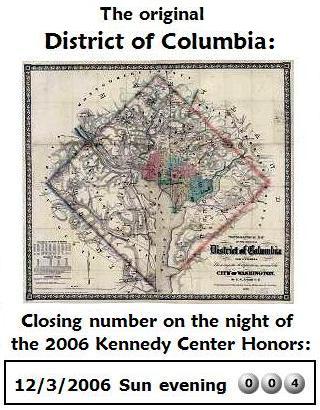
The map shows the original
(pre-1846) diamond shape
of the District of Columbia.
For the relevance of the
closing number of “Candide”
to diamonds, see
the previous entry.
For the relevance of the
closing number of the
12/3/06 DC lottery, see
Theme and Variations.
For the relevance of the
earlier mid-day number,
see the conclusion of
“Esthétique du Mal” —
“And out of what one sees
and hears and out
Of what one feels, who could
have thought to make
So many selves, so many
sensuous worlds,
As if the air, the mid-day air,
was swarming
With the metaphysical changes
that occur,
Merely in living
as and where we live.” |

A search on the mid-day number
in the context of metaphysics
yields the following:

Related material:
“In ‘
Esthétique du Mal,’ one of his later poems, Wallace Stevens considers existence from a variety of critical and philosophical perspectives, among them various moral, aesthetic, political, theological, and philosophic ‘epistemes’ that condition how humanity perceives and experiences the world. These epistemological ‘modes’ dictate how we live and perceive the world about us, providing preconceptions that shroud understanding and obfuscate ontological explanation. What Stevens accomplishes in ‘
Esthétique du Mal‘ is to create a dialogue with various historical and philosophical ‘schools,’ systematically confronting and rejecting their perspectives, and creating a movement toward Martin Heidegger’s ‘aletheia’ to uncover the ontological substructure that exists beneath the individual’s experience in the world. This movement of ‘uncovering’ and exposing the nature of what it means ‘to be in the world’ is a journey to an ontological substructure that allows Stevens to arrive at a dynamic, ontological proof: that existence is full of ‘reverberating’ possibilities, not solitary and ‘univocal’ statements.”
— Conversations with the Dead:
The Ontological Substructure of
Wallace Stevens’s “Esthétique du Mal“—
a 1999 Master’s thesis
For further remarks on
ontological substructure,
see A First Class Degree
(on a notable graduate of
Christ Church, Oxford).
Comments Off on Sunday December 31, 2006
Tuesday, December 26, 2006
Today in History
by The Associated Press:
Today is Tuesday, Dec. 26, the 360th day of 2006. There are five days left in the year. The seven-day African-American holiday Kwanzaa begins today. This is Boxing Day.
Comments Off on Tuesday December 26, 2006
Sunday, December 24, 2006


Click on picture
for further details.

Click on picture
for further details.
Comments Off on Sunday December 24, 2006
Saturday, December 23, 2006
Black Mark
Bernard Holland in The New York Times on Monday, May 20, 1996:
“Philosophers ponder the idea of identity: what it is to give something a name on Monday and have it respond to that name on Friday….”
|
Lottery on Friday,
Dec. 22, 2006:
|
Analysis of the structure
of a 2x2x2 cube
via trinities of
projective points
in a Fano plane.
Comments Off on Saturday December 23, 2006
Thursday, December 21, 2006
Strings Attached
From
a New York Times review on Monday, Dec. 18, 2006, of the play “Strings”–
The three main characters “spend much of the play discussing quantum mechanics, string theory and Schrödinger’s Cat experiment….
Ms. Buggé’s frequently clever script makes the audience feel smart by offering up fairly recognizable literary references (from, among other things, T. S. Eliot’s ‘Love Song of J. Alfred Prufrock’ and William Wordsworth’s ‘Tintern Abbey’). But the play suffers from abrupt, sometimes motivation-free exits and entrances.”
As does life itself.
|
The Conjecture:
Preludes to
Last Summer’s
String Theory
Conference
Oh, do not ask, “What is it?“ |
| Let us go and make our visit.
|
| On Tuesday evening, the schedule says “Prof. Yau present his new research result,” which presumably will be about the proof of the Poincare conjecture.
|
| Would it have been worth while, |
To have bitten off the matter
with a smile, |
To have squeezed the universe
into a ball |
To roll it toward some
overwhelming question….
|
Yau rated the conjecture as one of the major mathematical puzzles of the 20th Century.
|
Five years have passed;
five summers, with the length
Of five long winters!
— William Wordsworth |
Comments Off on Thursday December 21, 2006
Saturday, December 16, 2006
Cubism1 as Multispeech2
A quotation omitted from the above excerpt:
In Ulysses, there is "… the same quality of simultaneity as in cubist collage. Thus, for example, Bloom surveys the tombstones at Paddy Dignam's funeral and, in the midst of platitudinous and humorous thoughts, remembers Molly 'wanting to do it at the window'…."
Related material from quotations at the poetry journal eratio:
"The guiding law of the great variations in painting is one of disturbing simplicity. First things are painted; then, sensations; finally, ideas. This means that in the beginning the artist's attention was fixed on external reality; then, on the subjective; finally, on the intrasubjective. These three stages are three points on a straight line."
— Jose Ortega y Gasset ("On Point of View in the Arts," an essay on the development of cubism)
Related material on
tombstones and windows:
Geometry's Tombstones,
Galois's Window, and
Architecture of Eternity.

See also the following part
of the eratio quotations:

Quotations arranged by
Gregory Vincent St. Thomasino
Thursday, December 14, 2006
Hamlet’s Transformation,
continued from Sept. 6:

Click on picture
for details.
Comments Off on Thursday December 14, 2006
Monday, December 11, 2006
Geometry and Death
J. G. Ballard on “the architecture of death“:
“… a huge system of German fortifications that included the Siegfried line, submarine pens and huge flak towers that threatened the surrounding land like lines of Teutonic knights. Almost all had survived the war and seemed to be waiting for the next one, left behind by a race of warrior scientists obsessed with geometry and death.”
— The Guardian, March 20, 2006
Edward Hirsch on Lorca:
“For him, writing is a struggle both with geometry and death.”
— “The Duende,” American Poetry Review, July/August 1999
“Rosenblum writes with
absolute intellectual honesty,
and the effect is sheer liberation….
The disposition of the material is
a model of logic and clarity.”
— Harper’s Magazine review
quoted on back cover of
Cubism and Twentieth-Century Art,
by Robert Rosenblum
(Abrams paperback, 2001)
SINGER, ISAAC:
“Are Children the Ultimate Literary Critics?”
— Top of the News 29 (Nov. 1972): 32-36.
“Sets forth his own aims in writing for children
and laments ‘slice of life’ and chaos in
children’s literature. Maintains that children
like good plots, logic, and clarity,
and that they have a concern for
‘so-called eternal questions.'”
— An Annotated Listing of Criticism
by Linnea Hendrickson
“She returned the smile, then looked
across the room to her youngest brother,
Charles Wallace, and to their father,
who were deep in concentration, bent
over the model they were building
of a tesseract: the square squared,
and squared again: a construction
of the dimension of time.”
— A Swiftly Tilting Planet,
by Madeleine L’Engle
For “the dimension of time,”
see A Fold in Time,
Time Fold, and
Diamond Theory in 1937.
“… Philip of Austria… longing to discover the Muse and the Angel in theology, found himself imprisoned by the Duende of cold ardors in that masterwork of the Escorial, where geometry abuts with a dream and the Duende wears the mask of the Muse for the eternal chastisement of the great king.”
Perhaps. Or perhaps Philip, “the lonely
hermit of the Escorial,” is less lonely now.
Comments Off on Monday December 11, 2006
Sunday, December 10, 2006
Comments Off on Sunday December 10, 2006
On This Date
“… in 1896 Alfred Nobel,
the inventor of dynamite and
founder of the Nobel prizes,
died in San Remo, Italy,
at age 63.”
— “Today in History,”
by The Associated Press
… And the Nobel Prize
for Bullshit goes to…
First Runner-up —
A Piece of Justice.
From a summary of the novel:
The story deals with “one Gideon Summerfield, deceased.” Summerfield, a former tutor at (the fictional) St. Agatha’s College, Cambridge University, “is about to become the recipient of the Waymark prize. This prize is awarded in Mathematics and has the same prestige as the Nobel….”
Comments Off on Sunday December 10, 2006
The Librarian
"Like all men of the Library,
I have traveled in my youth."
— Jorge Luis Borges,
The Library of Babel
"Papá me mandó un artículo
de J. G. Ballard en el que
se refiere a cómo el lugar
de la muerte es central en
nuestra cultura contemporánea."
— Sonya Walger,
interview dated September 14
(Feast of the Triumph of the Cross),
Anno Domini 2006
Walger's father is, like Borges,
from Argentina.
She "studied English Literature
at Christ Church College, Oxford,
where she received
a First Class degree…. "
—Wikipedia
"… un artículo de J. G. Ballard…."–
A Handful of Dust, by J. G. Ballard
(The Guardian, March 20, 2006):
"… The Atlantic wall was only part of a huge system of German fortifications that included the Siegfried line, submarine pens and huge flak towers that threatened the surrounding land like lines of Teutonic knights. Almost all had survived the war and seemed to be waiting for the next one, left behind by a race of warrior scientists obsessed with geometry and death.
Death was what the Atlantic wall and Siegfried line were all about….
… modernism of the heroic period, from 1920 to 1939, is dead, and it died first in the blockhouses of Utah beach and the Siegfried line…
Modernism's attempt to build a better world with the aid of science and technology now seems almost heroic. Bertolt Brecht, no fan of modernism, remarked that the mud, blood and carnage of the first world war trenches left its survivors longing for a future that resembled a white-tiled bathroom. Architects were in the vanguard of the new movement, led by Le Corbusier and the Bauhaus design school. The old models were thrown out. Function defined form, expressed in a pure geometry that the eye could easily grasp in its entirety."

"This is the garden of Apollo,
the field of Reason…."
— John Outram, architect
(Click on picture for details.)
Comments Off on Sunday December 10, 2006
| The Lottery 12/9/06 |
Mid-day |
Evening |
| New York |
036
See
The Quest
for the 36 |
331
See 3/31—
“square crystal” and “the symbolism could not have been more perfect.” |
| Pennsylvania |
602
See 6/02—
Walter Benjamin
on
“Adamic language.” |
111
See 1/11—
“Related material:
Jung’s Imago and Solomon’s Cube.”
|
Comments Off on Sunday December 10, 2006
Wednesday, December 6, 2006
Tompkins was found dead
on December 1, 2006.
From Log24 on that date:

That entry contained an excerpt from
Tom Wolfe’s The Painted Word—
“What I saw before me was the critic-in-chief of The New York Times saying: In looking at a painting today, ‘to lack a persuasive theory is to lack something crucial.’ I read it again. It didn’t say ‘something helpful’ or ‘enriching’ or even ‘extremely valuable.’ No, the word was crucial….”
The story deals with “one Gideon Summerfield, deceased.” Summerfield, a former tutor at (the fictional) St. Agatha’s College, Cambridge University, “is about to become the recipient of the Waymark prize. This prize is awarded in Mathematics and has the same prestige as the Nobel. Summerfield had a rather lackluster career at St. Agatha’s, with the exception of one remarkable result that he obtained. It is for this result that he is being awarded the prize, albeit posthumously.” Someone is apparently trying to prevent a biography of Summerfield from being published.
The following page contains
a critical part of the solution
to the mystery:
Comments Off on Wednesday December 6, 2006
Saturday, December 2, 2006
Venus at
St. Anne's,
continued
In honor of
the film "Bobby,"
now playing.
("Venus at St. Anne's"
is the title of the final
chapter of
the C. S. Lewis classic
That Hideous Strength.)

Symbol of Venus
and
Symbol of Plato
Related symbols:


Click on pictures
for details related tp
the Feast of St. Anne
(July 26).
"The best theology today,
in its repudiation of a
rhetorical religious idealism,
finds itself in agreement
with a recurrent note
in contemporary poetry….
We keep coming back
and coming back/
To the real: to the hotel
instead of the hymns/
That fall upon it
out of the wind. We seek/
… Nothing beyond reality.
Within it/
Everything,
the spirit’s alchemicana….
(From 'An Ordinary Evening
in New Haven,'
in The Collected Poems
of Wallace Stevens….)
… Not grim/
Reality, but reality grimly seen….
(Ibid.)"
— "The Church's
New Concern with the Arts,"
by Amos N. Wilder,
Hollis Professor
of Divinity, Emeritus,
at Harvard Divinity School,
in Christianity and Crisis,
February 18, 1957.
"All the truth in the world
adds up to one big lie."
Friday, November 24, 2006
Galois’s Window:
Geometry
from Point
to Hyperspace
by Steven H. Cullinane
Euclid is “the most famous
geometer ever known
and for good reason:
for millennia it has been
his window
that people first look through
when they view geometry.”
— Euclid’s Window:
The Story of Geometry
from Parallel Lines
to Hyperspace,
by Leonard Mlodinow
“…the source of
all great mathematics
is the special case,
the concrete example.
It is frequent in mathematics
that every instance of a
concept of seemingly
great generality is
in essence the same as
a small and concrete
special case.”
— Paul Halmos in
I Want To Be a Mathematician
Euclid’s geometry deals with affine
spaces of 1, 2, and 3 dimensions
definable over the field
of real numbers.
Each of these spaces
has infinitely many points.
Some simpler spaces are those
defined over a finite field–
i.e., a “Galois” field–
for instance, the field
which has only two
elements, 0 and 1, with
addition and multiplication
as follows:
We may picture the smallest
affine spaces over this simplest
field by using square or cubic
cells as “points”:

From these five finite spaces,
we may, in accordance with
Halmos’s advice,
select as “a small and
concrete special case”
the 4-point affine plane,
which we may call

Galois’s Window.
The interior lines of the picture
are by no means irrelevant to
the space’s structure, as may be
seen by examining the cases of
the above Galois affine 3-space
and Galois affine hyperplane
in greater detail.
For more on these cases, see
The Eightfold Cube,
Finite Relativity,
The Smallest Projective Space,
Latin-Square Geometry, and
Geometry of the 4×4 Square.
(These documents assume that
the reader is familar with the
distinction between affine and
projective geometry.)
These 8- and 16-point spaces
may be used to
illustrate the action of Klein’s
simple group of order 168
and the action of
a subgroup of 322,560 elements
within the large Mathieu group.
The view from Galois’s window
also includes aspects of
quantum information theory.
For links to some papers
in this area, see
Elements of Finite Geometry.
Comments Off on Friday November 24, 2006
Wednesday, November 22, 2006
Windmill and Diamond
From “Today in History,”
by The Associated Press:
On this date:
In 1965, the musical
“Man of La Mancha”
opened in New York.
In 1975, Juan Carlos
was proclaimed
King of Spain.
Today’s birthdays:
… Movie director
Arthur Hiller is 83….
Hiller directed the 1972 film
of “Man of La Mancha.”
A quotation from that film:
“When life itself seems lunatic,
who knows where madness lies?”
One can approach these symbols in either a mathematical or a literary fashion. For a mathematical discussion of the symbols’ structure, see Theme and Variations. Those who prefer literary discussions may make up their own stories.
“Plato is wary of all forms of rapture other than reason’s. He is most deeply leery of, because himself so susceptible to, the literary imagination. He speaks of it as a kind of holy madness or intoxication and goes on to link it to Eros, another derangement that joins us, but very dangerously, with the gods.”
“It’s all in Plato, all in Plato;
bless me, what do they
teach them at these schools?”
— C. S. Lewis in
The Narnia Chronicles
Comments Off on Wednesday November 22, 2006
Thursday, November 16, 2006
“Let all thy words be counted.”
Dante, Inf., canto X.
Words for
G. Robert Crowningshield,
a developer of the International Diamond
Grading System™
According to a
press release,
Crowningshield
died on
November 8.
See Grave Matters,
an entry of that date,
and its links to
Geometry’s Tombstones,
Birth, Death, and Symmetry,
and
Religious Symbolism
at Princeton.
| Dante, Inferno, Canto X, 37-39:
E l’animose man del duca e pronte
mi spinser tra le sepulture a lui,
dicendo: “Le parole tue sien conte.”
And the bold and ready hands
of my Leader
pushed me between the tombs to him,
saying: “Let thy words be fitting”.
“Make your words count,”
Virgil instructs Dante:
“Speak aptly, make what you say
appropriate to the situation.”
|
Perhaps Crowningshield’s
Leader will be…

Niemoller is noted for his role in
the movement that led to the
Barmen Declaration, discussed in
Presbyterian Creedal Standards—
linked to in the above-cited
Religious Symbolism
at Princeton
(…that lay in the house
that Jack built).

Comments Off on Thursday November 16, 2006
Friday, November 10, 2006
Today's
numbers:
![PA lottery Nov. 10, 2006: Mid-day 588, Evening 004]()
Today is the day that
Stanley found Livingstone.

Click on picture for details.
"Stone 588,
I presume?"
Related material:
This afternoon's entry
on color symmetry
and

Click on picture for details.
See, too, the following from
a Log24 entry of last Monday–
"To von Eschenbach, the Grail
was never really a material cup,
but a jewel like the
jewel in the lotus,
a symbol of enlightenment,
of something intangible
and always beyond reach."
— Arcadian Functor
"Philosophers ponder the idea
of identity: what it is to give
something a name
on Monday
and have it respond
to that name
on Friday…."
— Bernard Holland in
The New York Times
Monday, May 20, 1996
Comments Off on Friday November 10, 2006
Wednesday, November 8, 2006
Comments Off on Wednesday November 8, 2006
Tuesday, November 7, 2006
A Game of Chess

"And these chessmen are men and women as they appear to themselves and to one another in this world. And the silver table is Time. And those who stand and watch are the immortal souls of these same men and women."

I Ching chessboard
Related material:
"At the still point,
there the dance is"
and

Comments Off on Tuesday November 7, 2006
Saturday, November 4, 2006
Links to some applications of finite geometry to quantum information theory have been added to finitegeometry.org.
Comments Off on Saturday November 4, 2006
Friday, November 3, 2006
First to Illuminate
“From the History of a Simple Group” (pdf), by Jeremy Gray:
“The American mathematician A. B. Coble [1908; 1913]* seems to have been the first to illuminate the 27 lines and 28 bitangents with the elementary theory of geometries over finite fields.
The combinatorial aspects of all this are pleasant, but the mathematics is certainly not easy.”
* [Coble 1908] A. Coble, “A configuration in finite geometry isomorphic with that of the 27 lines on a cubic surface,” Johns Hopkins University Circular 7:80-88 (1908), 736-744.
[Coble 1913] A. Coble, “An application of finite geometry to the characteristic theory of the odd and even theta functions,” Trans. Amer. Math. Soc. 14 (1913), 241-276.
Comments Off on Friday November 3, 2006
Wednesday, November 1, 2006

Clifford Geertz
Professor Emeritus,
Institute for Advanced Study
Savage Logic
"Savage logic works like a kaleidoscope whose chips can fall into a variety of patterns while remaining unchanged in quantity, form, or color. The number of patterns producible in this way may be large if the chips are numerous and varied enough, but it is not infinite. The patterns consist in the disposition of the chips vis-a-vis one another (that is, they are a function of the relationships among the chips rather than their individual properties considered separately). And their range of possible transformations is strictly determined by the construction of the kaleidoscope, the inner law which governs its operation. And so it is too with savage thought. Both anecdotal and geometric, it builds coherent structures out of 'the odds and ends left over from psychological or historical process.'
These odds and ends, the chips of the kaleidoscope, are images drawn from myth, ritual, magic, and empirical lore. (How, precisely, they have come into being in the first place is one of the points on which Levi-Strauss is not too explicit, referring to them vaguely as the 'residue of events… fossil remains of the history of an individual or a society.') Such images are inevitably embodied in larger structures– in myths, ceremonies, folk taxonomies, and so on– for, as in a kaleidoscope, one always sees the chips distributed in some pattern, however ill-formed or irregular. But, as in a kaleidoscope, they are detachable from these structures and arrangeable into different ones of a similar sort. Quoting Franz Boas that 'it would seem that mythological worlds have been built up, only to be shattered again, and that new worlds were built from the fragments,' Levi-Strauss generalizes this permutational view of thinking to savage thought in general."
— Clifford Geertz, "The Cerebral Savage: the Structural Anthropology of Claude Levi-Strauss," in Encounter, Vol. 28 No. 4 (April 1967), pp. 25-32.
Today's New York Times
reports that
Geertz died on Monday,
October 30, 2006.
Related material:
Kaleidoscope Puzzle,
Being Pascal Sauvage,
and Up the River:
|
While it's a story that's never been written, a suggested title– Indiana Jones Sails Up The River Of Death–

shows how readily we as individuals or we as a culture can automatically visualize a basic story motif. We may each see the particular elements of the story differently, but almost instantaneously we catch its drift.
The hero sails up the river of death to discover what lies within his own heart: i.e., how much moral and physical strength he has.
Indiana Jones sails up the River of Death.
We are following Indiana Jones up the River of Death. We're going to visit with Colonel Kurtz. (You may not want to get off the boat.)
No, I am not mixing up metaphors.
These are the Story.
|
Amen.
Comments Off on Wednesday November 1, 2006
Tuesday, October 31, 2006
"The show has an endgame, end-time mood….
I would call all these strategies fear of form…. the dismissal of originality is perhaps the oldest ploy in the postmodern playbook. To call yourself an artist at all is by definition to announce a faith, however unacknowledged, in some form of originality, first for yourself, second, perhaps, for the rest of us.
Fear of form above all means fear of compression– of an artistic focus that condenses experiences, ideas and feelings into something whole, committed and visually comprehensible."
— Roberta Smith
It is doubtful that Smith
would consider the
following "found" art an
example of originality.
It nevertheless does
"announce a faith."

"First for yourself"
Today's mid-day
Pennsylvania number:
707
See Log24 on 7/07
and the above review.
"Second, perhaps,
for the rest of us"
Today's evening
Pennsylvania number:
384
This number is an
example of what the
reviewer calls "compression"–
"an artistic focus that condenses
experiences, ideas and feelings
into something
whole, committed
and visually comprehensible."
"Experiences"
See (for instance)
Joan Didion's writings
(1160 pages, 2.35 pounds)
on "the shifting phantasmagoria
which is our actual experience."
Comments Off on Tuesday October 31, 2006
Wednesday, October 25, 2006
“… there is some virtue in tracking cultural trends in terms of their relation to the classic Trinitarian framework of Christian thought.”
— Description of lectures to be given Monday, Tuesday, and Wednesday of this week (on Father, Son, and Holy Spirit, respectively, and their relationship to “cultural trends”) at Harvard’s Memorial Church
I prefer more-classic trinitarian frameworks– for example,

and the structural trinity
underlying
classic quilt patterns:

Click on pictures for further details.
These mathematical trinities are
conceits in the sense of concepts
or notions; examples of the third
kind of conceit are easily
found, especially at Harvard.
For a possible corrective to
examples of the third kind,
see
To Measure the Changes.
Comments Off on Wednesday October 25, 2006
Saturday, October 21, 2006
An application of the finite geometry underlying the diamond theorem:
“Qubits in phase space: Wigner function approach to quantum error correction and the mean king problem,” by Juan Pablo Paz, Augusto Jose Roncaglia, and Marcos Saraceno (arXiv:quant-ph/0410117 v2 4 Nov 2004) (pdf)
Comments Off on Saturday October 21, 2006
Thursday, October 19, 2006
Comments Off on Thursday October 19, 2006
Comments Off on Thursday October 19, 2006
Monday, October 9, 2006
Comments Off on Monday October 9, 2006
Sunday, October 8, 2006
Today's Birthday:
Matt Damon
"The man who lives in contact with what he believes to be a living Church is a man always expecting to meet Plato and Shakespeare to-morrow at breakfast."
— G. K. Chesterton
See also works by the late Arthur Loeb of Harvard's Department of Visual and Environmental Studies.
"I don't want to be a product of my environment. I want my environment to be a product of me." — Frank Costello in The Departed
For more on the Harvard environment,
see today's online Crimson:
The Harvard Crimson,
Online Edition
|
Sunday,
Oct. 8, 2006
|
|
POMP AND
CIRCUS-STANCE

CRIMSON/ MEGHAN T. PURDY
Friday, Oct. 6:
The Ringling Bros. Barnum & Bailey Circus has come to town, and yesterday the animals were disembarked near MIT and paraded to their temporary home at the Banknorth Garden.
|
OPINION
At Last, a
Guiding Philosophy
The General Education report is a strong cornerstone, though further scrutiny is required.
By THE CRIMSON STAFF
After four long years, the Curricular Review has finally found its heart.
The Trouble
With the Germans
The College is a little under-educated these days.
By SAHIL K. MAHTANI
Harvard College– in the best formulation I’ve heard– promulgates a Japanese-style education, where the professoriate pretend to teach, the students pretend to learn, and everyone is happy.
|
Comments Off on Sunday October 8, 2006
Thursday, October 5, 2006
In Touch with God
(Title of an interview with
the late Paul Halmos, mathematician)
Since Halmos died on Yom Kippur, his thoughts on God may be of interest to some.
From a 1990 interview:
“What’s the best part of being a mathematician? I’m not a religious man, but it’s almost like being in touch with God when you’re thinking about mathematics. God is keeping secrets from us, and it’s fun to try to learn some of the secrets.”
I personally prefer Annie Dillard on God:
“… if Holy the Firm is matter at its dullest, Aristotle’s materia prima, absolute zero, and since Holy the Firm is in touch with the Absolute at base, then the circle is unbroken. And it is…. Holy the Firm is in short the philosopher’s stone.”
Some other versions of
the philosopher’s stone:

And, more simply,
April 28, 2004:

This last has the virtue of
being connected with Halmos
via his remarks during the
“In Touch with God” interview:
“…at the root of all deep mathematics there is a combinatorial insight… the really original, really deep insights are always combinatorial….”
“Combinatorics, the finite case, is where the genuine, deep insight is.”
See also the remark of Halmos that serves as an epigraph to Theme and Variations.
Comments Off on Thursday October 5, 2006
Tuesday, October 3, 2006
Serious
"I don't think the 'diamond theorem' is anything serious, so I started with blitzing that."
— Charles Matthews at Wikipedia, Oct. 2, 2006
"The 'seriousness' of a mathematical theorem lies, not in its practical consequences, which are usually negligible, but in the significance of the mathematical ideas which it connects. We may say, roughly, that a mathematical idea is 'significant' if it can be connected, in a natural and illuminating way, with a large complex of other mathematical ideas."
— G. H. Hardy, A Mathematician's Apology
Matthews yesterday deleted references to the diamond theorem and related material in the following Wikipedia articles:
Affine group
Reflection group
Symmetry in mathematics
Incidence structure
Invariant (mathematics)
Symmetry
Finite geometry
Group action
History of geometry
This would appear to be a fairly large complex of mathematical ideas.
See also the following "large complex" cited, following the above words of Hardy, in Diamond Theory:
Affine geometry, affine planes, affine spaces, automorphisms, binary codes, block designs, classical groups, codes, coding theory, collineations, combinatorial, combinatorics, conjugacy classes, the Conwell correspondence, correlations, design theory, duads, duality, error correcting codes, exceptional groups, finite fields, finite geometry, finite groups, finite rings, Galois fields, generalized quadrangles, generators, geometry, GF(2), GF(4), the (24,12) Golay code, group actions, group theory, Hadamard matrices, hypercube, hyperplanes, hyperspace, incidence structures, invariance, Karnaugh maps, Kirkman's schoolgirl problem, Latin squares, Leech lattice, linear groups, linear spaces, linear transformations, Mathieu groups, matrix theory, Meno, Miracle Octad Generator, MOG, multiply transitive groups, octads, the octahedral group, orthogonal arrays, outer automorphisms, parallelisms, partial geometries, permutation groups, PG(3,2), polarities, Polya-Burnside theorem, projective geometry, projective planes, projective spaces, projectivities, Reed-Muller codes, the relativity problem, Singer cycle, skew lines, sporadic simple groups, Steiner systems, symmetric, symmetry, symplectic, synthemes, synthematic, tesseract, transvections, Walsh functions, Witt designs.
Comments Off on Tuesday October 3, 2006
Sunday, October 1, 2006
The Joy of Six
Yom Kippur begins on the East Coast
at about 6:38 PM today.

Recommended holiday reading list
from Robert Langdon, Harvard author
of “the renowned collegiate texbook
Religious Iconology“ —
Elegance
Gerard Manley Hopkins on parallelism
Figures of Speech
Hamlet’s Transformation and the four
Log24 entries that preceded it
Finite Geometry of the Hexahedron
(Alternate title for the Christmas, 2005, entry)
Happy Six
Comments Off on Sunday October 1, 2006
Tales of Philosophy:
Recipe for Disaster
according to Jerome Kagan,
Harvard psychologist emeritus
|
From Log24 —
|

The Line
|

The Cube
|
From Harvard's
Jerome Kagan —
|
|
"'Humans demand that there be a clear right and wrong,' he said. 'You've got to believe that the track you've taken is the right track. You get depressed if you're not certain as to what it is you're supposed to be doing or what's right and wrong in the world.'"
|
"People need to divide the world into good and evil, us and them, Kagan continued. To do otherwise– to entertain the possibility that life is not black and white, but variously shaded in gray– is perhaps more honest, rational and decent. But it's also, psychically, a recipe for disaster."
|

Black and White:
Log24 in
May 2005
|

Shades of Gray:
An affine space
and
Harvard's
Jerome Kagan
|
The above Kagan quotes are taken
from a New York Times essay by
Judith Warner as transcribed by
Mark Finkelstein on Sept. 29.
See also Log24 on
Sept. 29 and 30.
Related material:
Kagan's book

Surprise, Uncertainty,
and Mental Structures
(Harvard U. Press, April 2002)
and Werner Heisenberg–
discoverer of the
uncertainty principle—
as Anakin Skywalker
being tempted by
the Dark Side:

George Lucas, who has profited
enormously from public depictions
of the clash between
good and evil, light and dark,
may in private life be inclined
"It is the brain, the little gray cells
on which one must rely.
One must seek the truth
within– not without."
(This is another version of the
"Descartes before dehors" principle–
Thursday, September 28, 2006
A Table
From the diary
of John Baez:
September 22, 2006
… Meanwhile, the mystics beckon:
Out beyond ideas of wrongdoing and rightdoing, there is a field. I’ll meet you there. – Rumi
September 23, 2006
I’m going up to San Rafael (near the Bay in Northern California) to visit my college pal Bruce Smith and his family. I’ll be back on Wednesday the 27th, just in time to start teaching the next day.
|
A check on the Rumi quote yields
this, on a culinary organization:
“Out beyond rightdoing and wrongdoing there is a field. I’ll meet you there.”
This is the starting place of good spirit for relationship healing and building prescribed centuries ago in the Middle East by Muslim Sufi teacher and mystic, Jelaluddin Rumi (1207-1273).
Even earlier, the Psalmists knew such a meeting place of adversaries was needed, sacred and blessed:
“Thou preparest a table before me in the presence of mine enemies….” (23rd Psalm)
|
A Field and a Table:

From “Communications Toolbox”
at MathWorks.com
For more on this field
in a different context, see
Generating the Octad Generator
and
“Putting Descartes Before Dehors”
in my own diary for December 2003.

Descartes

Après l’Office à l’Église
de la Sainte-Trinité, Noël 1890
(After the Service at Holy Trinity Church,
Christmas 1890), Jean Béraud
Let us pray to the Holy Trinity that
San Rafael guides the teaching of John Baez
this year. For related material on theology
and the presence of enemies, see Log24 on
the (former) Feast of San Rafael, 2003.
Comments Off on Thursday September 28, 2006
Wednesday, September 20, 2006
Public Space
"… the Danish cartoons crisis last March showed 'two world views colliding in public space with no common point of reference.'"
— George Carey, Archbishop of Canterbury from 1991 to 2002, quoted in today's London Times.
Related material:
Geometry and Christianity
(Google search yielding
"about 1,540,000" results)
Geometry and Islam
(Google search yielding
"about 1,580,000" results)
MySpace.com/affine

A Public Space

— Motto of
Plato's Academy
Background from
Log24 on Feb. 15, 2006:
|
If we replace the Chinese word "I" (change, transformation) with the word "permutation," the relevance of Western mathematics (which some might call "the Logos") to the I Ching ("Changes Classic") beomes apparent.
|
For the relevance of Plato to
Islam, see David Wade's
Pattern in Islamic Art
and a Google search on
Plato and Islam
("about 1,680,000" results).
"We should let ourselves be guided by what is common to all. Yet although the
Logos is common to all, most men live as if each had a private intelligence of his own."
— Heraclitus of Ephesus, about 500 B.C.
Comments Off on Wednesday September 20, 2006
Sunday, September 10, 2006
And the
"Meet Max Black"
Award goes to…

"For the Aeron and other designs,
Mr. Stumpf won this year’s
National Design Award
in Product Design,
which is to be presented
posthumously on Oct. 18
by the Cooper-Hewitt
National Design Museum
in Manhattan."
— Today's New York Times
Stumpf died on August 30,
the date of the Log24 entry
"The Seventh Symbol."
Related material:
From
Geometry of the I Ching,
a chessboard:

From the
National Design Museum:

From Log24 on the
date of Stumpf's death,
The Seventh Symbol:

Pictorial version of
Hexagram 20,
Contemplation (View)
See also
Fearful Symmetry
and
Symmetry Framed.
Comments Off on Sunday September 10, 2006
Wednesday, September 6, 2006
Hamlet's Transformation
"O God, I could be bounded in a nutshell
and count myself a king of infinite space,
were it not that I have bad dreams."
— Hamlet
Background:
-
Monday's "In a Nutshell,"
-
Tuesday's "The King of Infinite Space," and
-
this morning's "Bad Dreams."
Hamlet, 2.2:
"… Something have you heard
Of Hamlet's transformation; so call it,
Sith nor the exterior nor the inward man
Resembles that it was…."
The transformation:

Click on picture for details.
Related material:
Figures of Speech (June 7, 2006) and
Ursprache Revisited (June 9, 2006).
Comments Off on Wednesday September 6, 2006
Tuesday, September 5, 2006
The King of
Infinite Space
was published today.

Click on picture for details.
Comments Off on Tuesday September 5, 2006
Monday, September 4, 2006
In a Nutshell:
The Seed
"The symmetric group S6 of permutations of 6 objects is the only symmetric group with an outer automorphism….
This outer automorphism can be regarded as the seed from which grow about half of the sporadic simple groups…."
— Noam Elkies, February 2006
This "seed" may be pictured as
within what Burkard Polster has called "the smallest perfect universe"– PG(3,2), the projective 3-space over the 2-element field.
Related material: yesterday's entry for Sylvester's birthday.
Comments Off on Monday September 4, 2006
Sunday, September 3, 2006
The following figure from a June 11, 1986, note illustrates Sylvester's "duads" and "synthemes" using the concept of an "inscape" (part B of the figure). As R. T. Curtis and Noam Elkies have explained, the duads and synthemes lead to constructions of many of the sporadic simple groups.
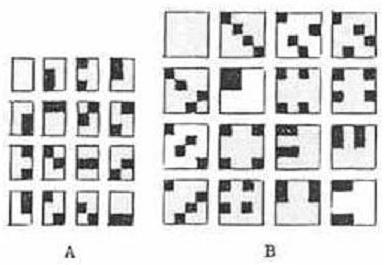
Comments Off on Sunday September 3, 2006
Wednesday, August 30, 2006
The Seventh Symbol:
A Multicultural Farewell
to a winner of the
Nobel Prize for Literature,
the Egyptian author of
The Seventh Heaven:
Supernatural Stories —


"Jackson has identified
the seventh symbol."
— Stargate
Other versions of
the seventh symbol —
Chinese version:

pictorial version:

algebraic version:

"… Max Black, the Cornell philosopher, and others have pointed out how 'perhaps every science must start with metaphor and end with algebra, and perhaps without the metaphor there would never have been any algebra' …."
— Max Black, Models and Metaphors, Cornell U. Press, 1962, page 242, as quoted in Dramas, Fields, and Metaphors, by Victor Witter Turner, Cornell U. Press, paperback, 1975, page 25
Monday, August 28, 2006
Today's Sinner:
Augustine of Hippo, who is said to
have died on this date in 430 A.D.
"He is, after all, not merely taking over a Neoplatonic ontology, but he is attempting to combine it with a scriptural tradition of a rather different sort, one wherein the divine attributes most prized in the Greek tradition (e.g. necessity, immutability, and atemporal eternity) must somehow be combined with the personal attributes (e.g. will, justice, and historical purpose) of the God of Abraham, Isaac, and Jacob."
— Stanford Encyclopedia of Philosophy on Augustine
Here is a rather different attempt
to combine the eternal with the temporal:
|
The Eternal
Symbol of necessity,
immutability, and
atemporal eternity:

For details, see
finite geometry of
the square and cube.
|
The Temporal
Symbol of the
God of Abraham,
Isaac, and Jacob:

For details, see
Under God
(Aug. 11, 2006)
|
The eternal
combined with
the temporal:

|
Related material:
Hitler's Still Point and
the previous entry.
Comments Off on Monday August 28, 2006
Saturday, August 26, 2006
"Alcatraz, Spanish for pelican, was named Isla de los Alcatraces after the birds that were the island's only inhabitants." —Bay City Guide
Related material
Thomas Kuhn's "Pelican Brief":
"… the Philosopher’s Stone was a psychic rather than a physical product. It symbolized one’s Self…."
Philosopher's Pelican:
"The formula presents a symbol of the self…."
Jung and the Imago Dei:
"… Jung presents a diagram to illustrate the dynamic movements of the self…."
…the movement of
a self in the rock…
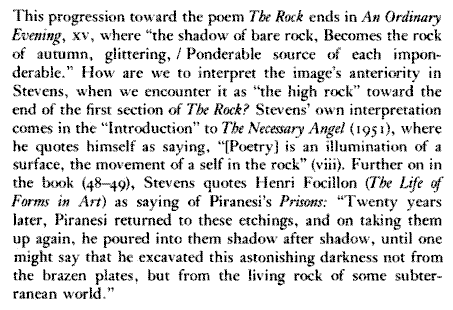
— Wallace Stevens:
The Poems of Our Climate,
by Harold Bloom,
Cornell U. Press, 1977
Comments Off on Saturday August 26, 2006
Tuesday, August 22, 2006
Introductions
In talks at Valencia, Spain, in May through August of 2004, Alexander Borisenko, of Kharkov National University in the Ukraine, provided a detailed introduction to the topic of today’s opening lecture at ICM 2006 in Madrid:
An Introduction to Hamilton and Perelman’s Work on the Conjectures of Poincare and Thurston (pdf, 155 pages).
For a less detailed introduction, see an ICM 2006 press release (pdf, 3 pages) on Fields Medal winner Grigory Perelman.
Related material: The previous entry, “Beginnings,” and an introduction to the second-simplest two-dimensional geometry (Balanchine’s Birthday, 2003).
“How much story do you want?”
— George Balanchine
Comments Off on Tuesday August 22, 2006
Beginnings
“Nothing ever begins.
There is no first moment; no single word or place from which this or any other story springs.
The threads can always be traced back to some earlier tale, and to the tales that preceded that; though as the narrator’s voice recedes the connections will seem to grow more tenuous, for each age will want the tale told as if it were of its own making.”
— Clive Barker, Weaveworld
“No mathematical subject lies closer to intuition than the geometry of two and three dimensions.”
— Robert E. Greene, beginning an April 1998 review of Three-Dimensional Geometry and Topology, by William P. Thurston
Thurston’s book provides some background for today’s opening lecture by Richard Hamilton, “The Poincare Conjecture,” at the beginning of the International Congress of Mathematicians in Madrid.
Hamilton is likely to discuss the Poincare conjecture in the wider context of Perelman‘s recent work on Thurston’s geometrization conjecture.
In “The Eight Model Geometries,” section 3.8 of his book, Thurston provides yet another beginning–
“What is a geometry?”
Comments Off on Tuesday August 22, 2006
Sunday, August 13, 2006
Comments Off on Sunday August 13, 2006
Friday, August 4, 2006
ART WARS
Continued from
Nov. 25, 2005
The Frankfurter School
From today’s New York Times:
A review of a current Manhattan art exhibition—
“It begins with a juxtaposition of early body-oriented videos by Mr. Nauman and Paul McCarthy, who, quickly following Mr. Nauman’s lead, was in his studio in Los Angeles videotaping home-alone performance pieces by 1970. The contrast is pure Apollo-versus-Dionysus.”
More on Paul McCarthy from artandculture.com:
“If you walk into a room and find everything you held dear in childhood degraded, chances are it’s a Paul McCarthy installation. McCarthy is known for shocking, sexually charged pieces that feature benign cartoon and pop-culture characters — Olive Oyl and Santa Claus, among others — in a bacchanalia of blood and feces.
The 1974 video ‘Hot Dog’ shoots to the heart of the adolescent ‘gross-out’ as McCarthy tapes his penis into a hot dog bun, then packs his pie hole full of franks and wraps himself in gauze. Another piece from the 70s called ‘Sailor’s Meat’ finds the artist dressed as a blonde hooker smeared with blood and ‘knowing’ a pile of raw meat….
Critics often compare his work with that of the Viennese Actionists whose performances were also characterized by gore, raw sexuality, and abused food.”
Related material:
The Wiener Kreis in
yesterday’s 1:06 PM entry
and the five entries
ending the afternoon of
Nov. 25, 2005.
For an approach to art
more in the spirit of Apollo
than of Dionysus, see
Geometry for Jews.
Comments Off on Friday August 4, 2006
Saturday, July 29, 2006
Big Rock
Thanks to Ars Mathematica, a link to everything2.com:
“In mathematics, a big rock is a result which is vastly more powerful than is needed to solve the problem being considered. Often it has a difficult, technical proof whose methods are not related to those of the field in which it is applied. You say ‘I’m going to hit this problem with a big rock.’ Sard’s theorem is a good example of a big rock.”
Another example:
Properties of the Monster Group of R. L. Griess, Jr., may be investigated with the aid of the Miracle Octad Generator, or MOG, of R. T. Curtis. See the MOG on the cover of a book by Griess about some of the 20 sporadic groups involved in the Monster:
The MOG, in turn, illustrates (via Abstract 79T-A37, Notices of the American Mathematical Society, February 1979) the fact that the group of automorphisms of the affine space of four dimensions over the two-element field is also the natural group of automorphisms of an arbitrary 4×4 array.
This affine group, of order 322,560, is also the natural group of automorphisms of a family of graphic designs similar to those on traditional American quilts. (See the diamond theorem.)
This top-down approach to the diamond theorem may serve as an illustration of the “big rock” in mathematics.
For a somewhat simpler, bottom-up, approach to the theorem, see Theme and Variations.
For related literary material, see Mathematics and Narrative and The Diamond as Big as the Monster.
“The rock cannot be broken.
It is the truth.”
— Wallace Stevens,
“Credences of Summer”
Comments Off on Saturday July 29, 2006
Wednesday, July 26, 2006
Venus at St. Anne’s
(Title of the closing chapter
of That Hideous Strength)

Symbol of Venus
and
Symbol of Plato
“What do they
teach them
at these schools?”
— C. S. Lewis
Today is the
feast of St. Anne.
Comments Off on Wednesday July 26, 2006
Comments Off on Wednesday July 26, 2006
Sunday, July 23, 2006
Dance of the Numbers, continued:
Partitions
Freeman Dyson on the role of the “crank” in the theory of partitions:
“‘Each step in the story is a work of art,’ Dyson says, ‘and the story as a whole is a sequence of episodes of rare beauty, a drama built out of nothing but numbers and imagination.'”
— Erica Klarreich in
Science News Online, week of
June 18, 2005, quoted in
“In Honor of Freeman Dyson’s Birthday:
Dance of the Numbers“
(Log24, Dec. 15, 2005)
Paraphrase of Freeman Dyson’s remarks in The New York Review of Books, issue dated May 28, 1998:
“Theology is about words; science is about things.“
“What is 256 about?”
— Reply to Freeman Dyson,
(May 15, 1998)
A partial answer to that rhetorical question: 256 is the cardinality of the power set of an 8-set.
For the role played by 8-sets and by 23 (today’s date) in partitions of a different sort, see Geometry of the 4×4 Square.
Comments Off on Sunday July 23, 2006
Tuesday, July 18, 2006
Sacred Order
In memory of Philip Rieff, who died on July 1, 2006:

Related material:

and

For details, see the
five Log24 entries ending
on the morning of
Midsummer Day, 2006.
That essay says Rieff had "a dense, knotty, ironic style designed to warn off impatient readers. You had to unpack his aphorisms carefully. And this took a while. As a result, his thinking had a time-release effect." Good for him. For a related essay (time-release effect unknown), see
Hitler's Still Point: A Hate Speech for Harvard.
Comments Off on Tuesday July 18, 2006
Thursday, July 13, 2006
Today's birthday:
Harrison Ford
"The forest here at the bottom of the canyon is mostly pine, with a few aspen and broad-leafed shrubs. Steep canyon walls rise way above us on both sides. Occasionally the trail opens into a patch of sunlight and grass that edges the canyon stream, but soon it reenters the deep shade of the pines. The earth of the trail is covered with a soft springy duff of pine needles. It is very quiet here.
Mountains like these and travelers in the mountains and events that happen to them here are found not only in Zen literature but in the tales of every major religion."– Robert Pirsig
"… a point of common understanding between the classic and romantic worlds. Quality, the cleavage term between hip and square, seemed to be it. Both worlds used the term. Both knew what it was. It was just that the romantic left it alone and appreciated it for what it was and the classic tried to turn it into a set of intellectual building blocks for other purposes."– Robert Pirsig
Comments Off on Thursday July 13, 2006
Tuesday, July 11, 2006
Not Crazy Enough?
Some children of the sixties may feel that today's previous two entries, on Syd Barrett, the Crazy Diamond, are not crazy enough. Let them consult the times of those entries– 2:11 and 8:15– and interpret those times, crazily, as dates: 2/11 and 8/15.
This brings us to Stephen King territory– apparently the natural habitat of Syd Barrett.
See Log24 on a 2/11, Along Came a Dreamcatcher, and Log24 on an 8/15, The Line.
From 8/15, a remark of Plato:
"There appears to be a sort of war of Giants and Gods going on…"
(Compare with the remarks by Abraham Cowley for Tom Stoppard's recent birthday.)
From 2/11, two links: Halloween Meditations and We Are the Key.
From Dreamcatcher (the film and the book):

For Syd Barrett as Duddits,

see Terry Kirby on Syd Barrett
(edited– as in Stephen King
and the New Testament—
for narrative effect):
"He appeared as the Floyd performed the song 'Shine On You Crazy Diamond.' It contains the words: 'Remember when you were young, you shone like the sun. Shine on you crazy diamond. Now there's a look in your eyes, like black holes in the sky.'
At first, they didn't recognise the man, whose head and eyebrows were shaved….
But this was the 'crazy diamond' himself: Syd Barrett, the subject of the song….
When Roger Waters saw his old friend, he broke down….
Rick Wright, the keyboards player, later told an interviewer:
… 'Roger [Waters] was in tears, I think I was; we were both in tears. It was very shocking… seven years of no contact and then to walk in while we're actually doing that particular track. I don't know – coincidence, karma, fate, who knows? But it was very, very, very powerful.'"
Remarks suitable for Duddits's opponent, Mister Gray, may be found in the 1994 Ph.D. thesis of Noel Gray.
"I refer here to Plato's utilisation in the Meno of graphic austerity as the tool to bring to the surface, literally and figuratively, the inherent presence of geometry in the mind of the slave."
Comments Off on Tuesday July 11, 2006
Sunday, July 9, 2006
Today’s birthday:
Tom Hanks, star of
“The Da Vinci Code”
Ben Nicholson
and the Holy Grail
Part I:
A Current Exhibit
A. Diamond Theory, a 1976 preprint containing, in the original version, the designs on the faces of Nicholson’s “Kufi blocks,” as well as some simpler traditional designs, and
B. “
Block Designs,” a web page illustrating design blocks based on the 1976 preprint.
Part III:
The Leonardo Connection
Part IV:
Nicholson’s Grail Quest
“I’m interested in locating the holy grail of the minimum means to express the most complex ideas.”
— Ben Nicholson in a 2005 interview
Nicholson’s quest has apparently lasted for some time. Promotional material for a 1996 Nicholson exhibit in Montreal says it “invites visitors of all ages to experience a contemporary architect’s search for order, meaning and logic in a world of art, science and mystery.” The title of that exhibit was “Uncovering Geometry.”
For web pages to which this same title might apply, see Quilt Geometry, Galois Geometry, and Finite Geometry of the Square and Cube.
* “Square Kufi” calligraphy is used in Islamic architectural ornament. I do not know what, if anything, is signified by Nicholson’s 6×12 example of “Kufi blocks” shown above.
Comments Off on Sunday July 9, 2006
Wednesday, July 5, 2006
And now, from
the author of Sphere…
CUBE
He beomes aware of something else… some other presence.
"Anybody here?" he says.
I am here.
He almost jumps, it is so loud. Or it seems loud. Then he wonders if he has heard anything at all.
"Did you speak?"
No.
How are we communicating? he wonders.
The way everything communicates with everything else.
Which way is that?
Why do you ask if you already know the answer?
— Sphere, by Michael Crichton, Harvard '64
"… when I went to Princeton things were completely different. This chapel, for instance– I remember when it was just a clearing, cordoned off with sharp sticks. Prayer was compulsory back then, and you couldn't just fake it by moving your lips; you had to know the words, and really mean them. I'm dating myself, but this was before Jesus Christ."
— Baccalaureate address at Princeton, Pentecost 2006, reprinted in The New Yorker, edited by David Remnick, Princeton '81
Comments Off on Wednesday July 5, 2006
Sunday, July 2, 2006
Review:

Comments Off on Sunday July 2, 2006
The Rock and the Serpent
In a search for a title to express
the contrast between truth and lies,
an analogy between the phrases
“Crystal and Dragon” and
“Mathematics and Narrative“
suggests a similar phrase,
“The Rock and the Serpent.”
A web search for related titles leads to a book by Alice Thomas Ellis:
Serpent on the Rock: A Personal View of Christianity. (See a review.)
(This in turn leads to an article on Ellis’s husband, the late Colin Haycraft, publisher.)
For an earlier discussion of Ellis in this weblog, see Three Eleanors (March 12, 2005).
That entry brings us back to the theme of truth and lies with its link to an article from the Catholic publication Commonweal:
Getting to Truth by Lying.
Christians who wish to lie more effectively may consult a book by the author of the Commonweal article:

For a more sympathetic view of
suffering stemming from
Christian narrative,
see

(Click on cover
for details. See also Log24
entries on Guy Davenport,
who wrote the foreword.)
Comments Off on Sunday July 2, 2006
Friday, June 30, 2006
Independence Day Cover
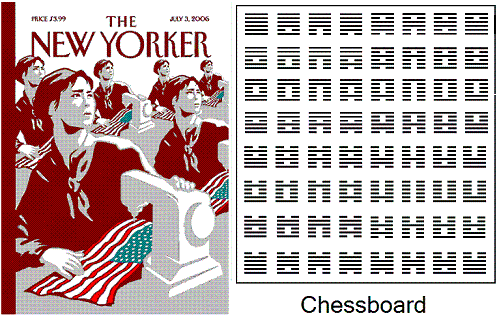
Click on picture for further details.
Comments Off on Friday June 30, 2006
Tuesday, June 27, 2006
Kaplansky received his doctorate in mathematics at Harvard in 1941 as the first Ph.D. student of Saunders Mac Lane.
From the April 25, 2005, Harvard Crimson:
Ex-Math Prof Mac Lane, 95, Dies
Gade University Professor of Mathematics Barry Mazur, a friend of the late Mac Lane, recalled that [a Mac Lane paper of 1945] had at first been rejected from a lower-caliber mathematical journal because the editor thought that it was “more devoid of content” than any other he had read.
“Saunders wrote back and said, ‘That’s the point,'” Mazur said. “And in some ways that’s the genius of it. It’s the barest, most Beckett-like vocabulary that incorporates the theory and nothing else.”
He likened it to a sparse grammar of nouns and verbs and a limited vocabulary that is presented “in such a deft way that it will help you understand any language you wish to understand and any language will fit into it.”
A sparse grammar of lines from Charles Sanders Peirce (Harvard College, class of 1859):
It
is true of this set of binary connectives, as it is true of logic generally, that (as alleged above of Mac Lane’s category theory)
“it will help you understand any language you wish to understand and any language will fit into it.” Of course, a great deal of questionable material has been written about these connectives. (See, for instance,
Piaget and
De Giacomo.) For remarks on the connectives that are
not questionable, see Wittgenstein’s
Tractatus Logico-Philosophicus (English version, 1922),
section 5.101, and Knuth’s “
Boolean Basics” (draft, 2006).
Related entry: Binary Geometry.
Comments Off on Tuesday June 27, 2006
Friday, June 23, 2006
Binary Geometry
There is currently no area of mathematics named “binary geometry.” This is, therefore, a possible name for the geometry of sets with 2n elements (i.e., a sub-topic of Galois geometry and of algebraic geometry over finite fields– part of Weil’s “Rosetta stone” (pdf)).
Examples:
- Charles Sanders Peirce, “The Simplest Mathematics.”
- Donald E. Knuth’s discussion of binary hypercubes in “Boolean Basics,” a draft of section 7.1.1 in The Art of Computer Programming, Volume 4: Combinatorial Algorithms
- My own discussion of a binary hypercube in Geometry of the 4x4x4 Cube
- A more sophisticated example: the geometry of elliptic curves over a binary Galois field. For an excellent introduction, see the Certicom online elliptic curve tutorial. This has an applet illustrating elliptic curves in a space of 256 points (256=16×16, with the x and y variables of a curve each having 16 possible values).
- In summary, apart from the fact that the native language of computers has characteristic 2, “binary” mathematics, i.e. mathematics in characteristic 2, is of special interest both in the study of finite geometry (Finite Geometry of the Square and Cube) and in algebraic geometry (see, for instance, the work of Brian Conrad).
Comments Off on Friday June 23, 2006
Wednesday, June 21, 2006
Go with the Flow
The previous entry links to a document that discusses the mathematical concept of "Ricci flow (pdf)."
Though the concept was not named for him, this seems as good a time as any to recall the virtues of St. Matteo Ricci, a Jesuit who died in Beijing on May 11, 1610. (The Church does not yet recognize him as a saint; so much the worse for the Church.)
There was no Log24 entry on Ricci's saint's day, May 11, this year, but an entry for 4:29 PM May 10, 2006, seems relevant, since Beijing is 12 hours ahead of my local (Eastern US) time.
Comments Off on Wednesday June 21, 2006
Tuesday, June 20, 2006
Hopkins on Parallelism
“The structure of poetry is that of continuous parallelism, ranging from the technical so-called Parallelism of Hebrew Poetry and the antiphons of Church music up to the intricacy of Greek or Italian or English verse. But parallelism is of two kinds necessarily – where the opposition is clearly marked, and where it is transitional rather or chromatic. Only the first kind, that of marked parallelism is concerned with the structure of verse — in rhythm, the recurrence of a certain sequence of rhythm, in alliteration, in assonance and in rhyme. Now the force of this recurrence is to beget a recurrence or parallelism answering to it in the words or thought and, speaking roughly and rather for the tendency than the invariable result, the more marked parallelism in structure whether of elaboration or of emphasis begets more marked parallelism in the words and sense. And moreover parallelism in expression tends to beget or passes into parallelism in thought. This point reached we shall be able to see and account for the peculiarities of poetic diction. To the marked or abrupt kind of parallelism belong metaphor, simile, parable, and so on, where the effect is sought in likeness of things, and antithesis, contrast, and so on, where it is sought in unlikeness. To the chromatic parallelism belong gradation, intensity, climax, tone, expression (as the word is used in music), chiaroscuro, perhaps emphasis: while the faculties of Fancy and Imagination might range widely over both kinds, Fancy belonging more especially to the abrupt than to the transitional class.”
— From Gerard Manley Hopkins, “Poetic Diction,” 1865
For an application to Hopkins’s poetry, see an excerpt from Stephen Prickett, Words and the Word: Language, Poetics and Biblical Interpretation (Cambridge: Cambridge University Press, 1986).
See also the publisher’s description of Maria R. Lichtmann’s The Contemplative Poetry of Gerard Manley Hopkins, Princeton University Press, 1989.
Comments Off on Tuesday June 20, 2006
Sunday, June 18, 2006
Gold Bug
Variations
The personae of summer
play the characters
Of an inhuman author,
who meditates
With the gold bugs,
in blue meadows,
late at night.
— Wallace Stevens,
“Credences of Summer,”
Canto X, Collected Poetry
and Prose, 322-326
Comments Off on Sunday June 18, 2006
Saturday, June 17, 2006
“Breaking the spell of religion is a
game that many people can play.”
— Freeman Dyson in the current
New York Review of Books
Part I:
The Game

Part II:
Many People

For further details,
see Solomon’s Cube
and myspace.com/affine.
“The rock cannot be broken.
It is the truth.”
— Wallace Stevens
Comments Off on Saturday June 17, 2006
Friday, June 16, 2006
For Bloomsday 2006:
Hero of His Own Story
"The philosophic college should spare a detective for me."
— Stephen Hero. Epigraph to Chapter 2, "Dedalus and the
Beauty Maze," in Joyce and Aquinas, by William T. Noon, S. J.,
Yale University Press, 1957 (in the Yale paperback edition of
1963, page 18)
"Dorothy Sayers makes a great deal of sense when she points out
in her highly instructive and readable book The Mind of the Maker
that 'to complain that man measures God by his own measure is
a waste of time; man measures everything by his own experience;
he has no other yardstick.'"
— William T. Noon, S. J., Joyce and Aquinas (in the Yale paperback
edition of 1963, page 106)
Related material:
-
Dorothy Sayers and Jill Paton Walsh
-
Jill Paton Walsh's detective novel A Piece of Justice (1995):
"The mathematics of tilings and quilting play background
roles in this mystery in which a graduate student attempts
to write a biography of the (fictitious) mathematician
Gideon Summerfield. Summerfield is about to posthumously
receive the prestigious (and, I should point out, also fictitious)
Waymark Prize in mathematics…but it soon becomes clear
that someone with evil intentions does not want the student's
book to be published!By all accounts this is a well written mystery…
the second by the author with college nurse Imogen Quy playing
the role of the detective."— Mathematical Fiction by Alex Kasman,
College of Charleston
AD PULCHRITUDINEM TRIA REQUIRUNTUR:
INTEGRITAS, CONSONANTIA, CLARITAS.
— St. Thomas Aquinas
Thursday, June 15, 2006
Baez Link
John Baez’s latest This Week’s Finds
(Week 234, June 12, 2006) has a link
to my “Geometry of the 4×4 Square” at
http://finitegeometry.org/sc/16/geometry.html.
Tuesday, May 30, 2006
The Mathematical
Association of America
discusses
finite geometry:

|
“One thing in the Fano plane that bothered me for years (for years, I say) is that it had a circle – and it was described as a line. For me, a line was a straight line, and I didn’t trust curved or wriggly lines. This distrust kept me away from understanding projective planes, designs, and finite geometries for a awhile (for years).”
|
“Against stupidity
the gods themselves
fight unvictorious.”
— Schiller,* quoted as
the epigraph to the
chapter on Galois in
Men of Mathematics,
by E. T. Bell
Related material:
Galois Geometry
* From Die Jungfrau von Orleans
(The Maid of Orleans), Act III, sc. vi.
Today is the feast of that Jungfrau.

Click on picture
for details.
Comments Off on Tuesday May 30, 2006
Friday, May 26, 2006
A Living Church
continued from March 27
"The man who lives in contact with what he believes to be a living Church is a man always expecting to meet Plato and Shakespeare to-morrow at breakfast."
— G. K. Chesterton
Comments Off on Friday May 26, 2006
Friday, May 12, 2006
Tesseract
"Does the word 'tesseract'
mean anything to you?"
— Robert A. Heinlein in
The Number of the Beast
(1980)
My reply–
Part I:
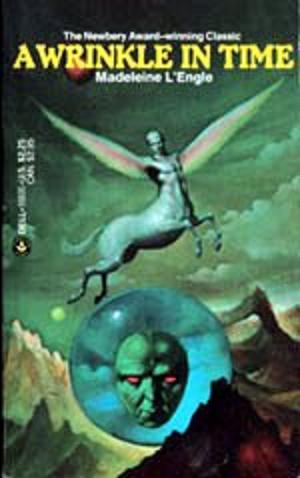
A Wrinkle in Time, by
Madeleine L'Engle
(first published in 1962)
Part II:

Diamond Theory in 1937
and
Geometry of the 4×4 Square
Part III:
Catholic Schools Sermon
Conclusion:
"Wells and trees were dedicated to saints. But the offerings at many wells and trees were to something other than the saint; had it not been so they would not have been, as we find they often were, forbidden. Within this double and intertwined life existed those other capacities, of which we know more now, but of which we still know little– clairvoyance, clairaudience, foresight, telepathy."
— Charles Williams, Witchcraft, Faber and Faber, London, 1941
Related material:
A New Yorker profile of Madeleine L'Engle from April 2004, which I found tonight online for the first time. For a related reflection on truth, stories, and values, see Saint's Day. For a wider context, see the Log24 entries of February 1-15, 2003 and February 1-15, 2006.
Comments Off on Friday May 12, 2006
Wednesday, May 10, 2006
“… we have condensed six dimensions into four, then we either work by analogy into six, or we have to use math that apparently nobody but Jake and my cousin Ed understands. Unless you can think of some way to project six dimensions into three– you seem to be smart at such projections.”
I closed my eyes and thought hard. “Zebbie, I don’t think it can be done. Maybe Escher could have done it.”
Comments Off on Wednesday May 10, 2006
Sunday, May 7, 2006
Bagombo Snuff Box
(in memory of
Burt Kerr Todd)
“Well, it may be the devil
or it may be the Lord
But you’re gonna have to
serve somebody.”
— “Bob Dylan”
(pseudonym of Robert Zimmerman),
quoted by “Bob Stewart”
on July 18, 2005
“Bob Stewart” may or may not be the same person as “crankbuster,” author of the “Rectangular Array Theorem” or “RAT.” This “theorem” is intended as a parody of the “Miracle Octad Generator,” or “MOG,” of R. T. Curtis. (See the Usenet group sci.math, “Steven Cullinane is a Crank,” July 2005, messages 51-60.)
“Crankbuster” has registered at Math Forum as a teacher in Sri Lanka (formerly Ceylon). For a tall tale involving Ceylon, see the short story “Bagombo Snuff Box” in the book of the same title by Kurt Vonnegut, who has at times embodied– like Martin Gardner and “crankbuster“– “der Geist, der stets verneint.”
Here is my own version (given the alleged Ceylon background of “crankbuster”) of a Bagombo snuff box:
Comments Off on Sunday May 7, 2006
Friday, April 28, 2006
Exercise
Review the concepts of integritas, consonantia, and claritas in Aquinas:
"For in respect to beauty three things are essential: first of all, integrity or completeness, since beings deprived of wholeness are on this score ugly; and [secondly] a certain required design, or patterned structure; and finally a certain splendor, inasmuch as things are called beautiful which have a certain 'blaze of being' about them…."
— Summa Theologiae Sancti Thomae Aquinatis, I, q. 39, a. 8, as translated by William T. Noon, S.J., in Joyce and Aquinas, Yale University Press, 1957
Review the following three publications cited in a note of April 28, 1985 (21 years ago today):
(1) Cameron, P. J.,
Parallelisms of Complete Designs,
Cambridge University Press, 1976.
(2) Conwell, G. M.,
The 3-space PG(3,2) and its group,
Ann. of Math. 11 (1910) 60-76.
(3) Curtis, R. T.,
A new combinatorial approach to M24,
Math. Proc. Camb. Phil. Soc.
79 (1976) 25-42.
Discuss how the sextet parallelism in (1) illustrates integritas, how the Conwell correspondence in (2) illustrates consonantia, and how the Miracle Octad Generator in (3) illustrates claritas.
Comments Off on Friday April 28, 2006
Tuesday, April 25, 2006
“There is a pleasantly discursive treatment
of Pontius Pilate’s unanswered question
‘What is truth?'”
— H. S. M. Coxeter, 1987, introduction to
Richard J. Trudeau’s remarks on
the “Story Theory” of truth
as opposed to
the “Diamond Theory” of truth
in The Non-Euclidean Revolution
A Serious Position
“‘Teitelbaum,’ in German,
is ‘date palm.'”
— Generations, Jan. 2003
“In Hasidism, a mystical brand
of Orthodox Judaism, the grand rabbi
is revered as a kinglike link to God….”
— Today’s New York Times obituary
of Rabbi Moses Teitelbaum,
who died on April 24, 2006
(Easter Monday in the
Orthodox Church)
NEW BOOKS: 02.16.05 Proofs and Paradoxes Alfred Teitelbaum changed his name to Tarski in the early 20s, the same time he changed religions, but when the Germans invaded his native Poland, the mathematician was in California, where he remained. His “great achievement was his
audacious assault on the notion of
truth,” says Martin Davis, focusing on the
semantics and syntax of scientific language.
Alfred Tarski: Life and Logic, co-written by a former student,
Solomon Feferman, offers “remarkably intimate information,” such as abusive teaching and “extensive amorous involvements.”
From Wikipedia, an unsigned story:
“In 1923 Alfred Teitelbaum and his brother Wacław changed their surnames to Tarski, a name they invented because it sounded very Polish, was simple to spell and pronounce, and was unused. (Years later, he met another Alfred Tarski in northern California.) The Tarski brothers also converted to Roman Catholicism, the national religion of the Poles. Alfred did so, even though he was an avowed atheist, because he was about to finish his Ph.D. and correctly anticipated that it would be difficult for a Jew to obtain a serious position in the new Polish university system.”
Comments Off on Tuesday April 25, 2006
Monday, April 10, 2006
"What other colleges call fraternities,
Princeton calls Eating Clubs."
Illustrated below:
The Restaurant Quarré in Berlin,
with a view of the Brandenburg Gate.

Related etymology:
OF. quarré square, F. carré,
from L. quadratus square…
— Webster's Revised
Unabridged Dictionary, 1913
Related material:
(1) A symbol of symmetry
that might have pleased
Hermann Weyl:
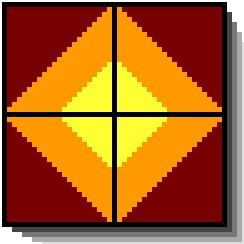
Source —
Timothy A. Smith on
Bach's Fugue No. 21,
the Well-Tempered
Clavier, Book II
(pdf or Shockwave)
(2) The remarks of Noam D. Elkies
on his
"Brandenburg Concerto No. 7":
"It is of course an act of chutzpah,
some would say almost heresy,
to challenge Bach so explicitly
on his own turf."
(3) The five Log24 entries
culminating on Pi Day,
March 14, 2006
(4) The following event at the
Harvard University
mathematics department
on March 14, 2006, also
featuring Noam D. Elkies:

"At 3:14 p.m., six contestants began
a pie-eating contest…. Contestants had
exactly three minutes and 14 seconds
to eat as much pie as they could.
'Five, four, pi, three, two, one,'
Elkies counted down as the
contestants shoved the last
mouthful of pie
into their mouths…."
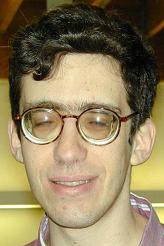
Noam D. Elkies
(5) The Magic Schmuck
Comments Off on Monday April 10, 2006
Thursday, April 6, 2006
Comments Off on Thursday April 6, 2006
Friday, March 31, 2006
Women's History Month continues…
Ontology Alignment
"He had with him a small red book of Mao's poems, and as he talked he squared it on the table, aligned it with the table edge first vertically and then horizontally. To understand who Michael Laski is you must have a feeling for that kind of compulsion."
— Joan Didion in the
Saturday Evening Post,
Nov. 18, 1967 (reprinted in
Slouching Towards Bethlehem)
"Or were you," I said.
He said nothing.
"Raised a Catholic," I said.
He aligned a square crystal paperweight with the edge of his desk blotter.
— Joan Didion in
The Last Thing He Wanted,
Knopf, 1996
"It was Plato who best expressed– who veritably embodied– the tension between the narrative arts and mathematics….
Plato clearly loved them both, both mathematics and poetry. But he approved of mathematics, and heartily, if conflictedly, disapproved of poetry. Engraved above the entrance to his Academy, the first European university, was the admonition: Oudeis ageometretos eiseto. Let none ignorant of geometry enter. This is an expression of high approval indeed, and the symbolism could not have been more perfect, since mathematics was, for Plato, the very gateway for all future knowledge. Mathematics ushers one into the realm of abstraction and universality, grasped only through pure reason. Mathematics is the threshold we cross to pass into the ideal, the truly real."
— Rebecca Goldstein,
Mathematics and
the Character of Tragedy
Comments Off on Friday March 31, 2006
Wednesday, March 29, 2006

Note: Carmichael's reference is to
A. Emch, "Triple and multiple systems, their geometric configurations and groups," Trans. Amer. Math. Soc. 31 (1929), 25–42.
"There is such a thing as a tesseract."
— A Wrinkle in Time
Comments Off on Wednesday March 29, 2006
Sunday, March 26, 2006
'Nauts
(continued from
Life of the Party, March 24)
Exhibit A —
From (presumably) a Princeton student
(see Activity, March 24):

Exhibit B —
From today's Sunday comics:

Exhibit C —
From a Smith student with the
same name as the Princeton student
(i.e., Dagwood's "Twisterooni" twin):

Related illustrations
("Visual Stimuli") from
the Smith student's game —

Literary Exercise:
Continuing the Smith student's
Psychonauts theme,
compare and contrast
two novels dealing with
similar topics:
A Wrinkle in Time,
by the Christian author
Madeleine L'Engle,
and
Psychoshop,
by the secular authors
Alfred Bester and
Roger Zelazny.
Presumably the Princeton student
would prefer the Christian fantasy,
the Smith student the secular.
Those who prefer reality to fantasy —
not as numerous as one might think —
may examine what both 4×4 arrays
illustrated above have in common:
their structure.
Both Princeton and Smith might benefit
from an application of Plato's dictum:

Comments Off on Sunday March 26, 2006
Clint Eastwood on the
“Midnight in the Garden
of Good and Evil”
soundtrack CD—
“Accentuate the positive”–
and an entry from last Christmas:
|
Compare and contrast:
(Click on pictures
for details.)

 |
“Recollect what I have said to you,
that this world is a comedy
to those who think,
a tragedy to those who feel.
This is the quint-essence of all
I have learnt in fifty years!”
— Horace Walpole,
letter to Horace Mann,
5 March, 1772
Comments Off on Sunday March 26, 2006
Thursday, March 23, 2006
Happy Birthday, Hassler Whitney
In honor of the late Hassler Whitney, mathematician and mountaineer, here is a link to the five Log24 entries ending with White, Geometric, and Eternal (Dec. 20, 2003).
Related material: the five Log24 entries ending with The Meadow (Dec. 18, 2005) and the five Log24 entries ending with Strange Attractor (Jan. 7, 2006).
The cross and the epiphany star in this last group of entries may interest the symbol-mongers among us.
Those more interested in substance than in symbols may prefer the following (click to enlarge):

This is apparently the original source for
the figure I cited on Dec. 20, 2003, as
from antiquark.com.
The connection with Whitney is
through the theory of matroids,
which Whitney founded in 1935.
See Hassler Whitney,
"On the abstract properties
of linear dependence,"
American Journal of Mathematics,
vol. 57 (1935), 509-533,
Collected Papers, vol. I, 147-171.
Comments Off on Thursday March 23, 2006
Friday, March 17, 2006
Dogma in the
State of Grace
“Words and numbers are of equal value,
for, in the cloak of knowledge,
one is warp and the other woof.”
— The princesses Rhyme and Reason
in The Phantom Tollbooth,
by Norton Juster, 1961
(From a Sermon for
St. Patrick’s Day, 2001)
The Pennsylvania midday lottery
on St. Patrick’s Day, 2006:
618.
Reason informs us that the lottery result “618” may be regarded as naming
” – 0.618,” the approximate value of the negative solution to
the equation x2 – x – 1 = 0

Following the advice of Clint Eastwood (on the “Midnight in the Garden of Good and Evil”
soundtrack CD) to “accentuate the positive,” Reason notes that the other, positive, solution to this equation, approximately 1.618, a number symbolized by the Greek letter “phi,” occurs in the following geometric diagram illustrating a construction of the pentagon:

For further enlightenment, we turn to Rhyme, who informs us that “618” may also be regarded as naming the date “6/18.” Consulting our notes, we find on
6/18, 2003, a reference to “
claves,” Latin for “keys,” as in “
claves regni caelorum.”

Alicia Keys
“… it’s going to be
accomplished in steps,
this establishment
of the Talented in
the scheme of things.”
— Anne McCaffrey,
Radcliffe ’47,
To Ride Pegasus
Comments Off on Friday March 17, 2006
Mackey was born, according to Wikipedia, on Feb. 1, 1916. He died, according to Harvard University, on the night of March 14-15, 2006. He was the author of, notably, "Harmonic Analysis as the Exploitation of Symmetry — A Historical Survey," pp. 543-698 in Bulletin of the American Mathematical Society (New Series), Vol. 3, No. 1, July 1980. This is available in a hardcover book published in 1992 by the A.M.S., The Scope and History of Commutative and Noncommutative Harmonic Analysis. (370 pages, ISBN 0-8218-9903-1). A paperback edition of this book will apparently be published this month by Oxford University Press (ISBN 978-0-8218-3790-7).
From Oxford U.P.–
Contents
-
Introduction
-
Harmonic analysis as the exploitation of symmetry: A historical survey
-
Herman Weyl and the application of group theory to quantum mechanics
-
The significance of invariant measures for harmonic analysis
-
Weyl's program and modern physics
-
Induced representations and the applications of harmonic analysis
-
Von Neumann and the early days of ergodic theory
-
Final remarks
Related material:
Log24, Oct. 22, 2002.
Women's history month continues.
Comments Off on Friday March 17, 2006
Sunday, March 12, 2006
A Circle of Quiet
From the Harvard Math Table page:
“No Math table this week. We will reconvene next week on March 14 for a special Pi Day talk by Paul Bamberg.”
Some friends of mine are in this band.
They’re playing in a bar on Diversey,
way down the bill, around…
I said I’d be there.
Great.
They’re all in the math department.
They’re good.
They have this song called “i.”
You’d like it. Lowercase i.
They just stand there.
They don’t play anything for three minutes.
Imaginary number?
It’s a math joke.
You see why they’re way down the bill. |
From the April 2006 Notices of the American Mathematical Society, a footnote in a review by Juliette Kennedy (pdf) of Rebecca Goldstein’s Incompleteness:
4 There is a growing literature in the area of postmodern commentaries of [sic] Gödel’s theorems. For example, Régis Debray has used Gödel’s theorems to demonstrate the logical inconsistency of self-government. For a critical view of this and related developments, see Bricmont and Sokal’s Fashionable Nonsense [13]. For a more positive view see Michael Harris’s review of the latter, “I know what you mean!” [9]….
[9] MICHAEL HARRIS, “I know what you mean!,” http://www.math.jussieu.fr/~harris/Iknow.pdf.
[13] ALAN SOKAL and JEAN BRICMONT, Fashionable Nonsense, Picador, 1999.
Following the trail marked by Ms. Kennedy, we find the following in Harris’s paper:
“Their [Sokal’s and Bricmont’s] philosophy of mathematics, for instance, is summarized in the sentence ‘A mathematical constant like  doesn’t change, even if the idea one has about it may change.’ ( p. 263). This claim, referring to a ‘crescendo of absurdity’ in Sokal’s original hoax in Social Text, is criticized by anthropologist Joan Fujimura, in an article translated for IS*. Most of Fujimura’s article consists of an astonishingly bland account of the history of non-euclidean geometry, in which she points out that the ratio of the circumference to the diameter depends on the metric. Sokal and Bricmont know this, and Fujimura’s remarks are about as helpful as FN’s** referral of Quine’s readers to Hume (p. 70). Anyway, Sokal explicitly referred to “Euclid’s pi”, presumably to avoid trivial objections like Fujimura’s — wasted effort on both sides.32 If one insists on making trivial objections, one might recall that the theorem
doesn’t change, even if the idea one has about it may change.’ ( p. 263). This claim, referring to a ‘crescendo of absurdity’ in Sokal’s original hoax in Social Text, is criticized by anthropologist Joan Fujimura, in an article translated for IS*. Most of Fujimura’s article consists of an astonishingly bland account of the history of non-euclidean geometry, in which she points out that the ratio of the circumference to the diameter depends on the metric. Sokal and Bricmont know this, and Fujimura’s remarks are about as helpful as FN’s** referral of Quine’s readers to Hume (p. 70). Anyway, Sokal explicitly referred to “Euclid’s pi”, presumably to avoid trivial objections like Fujimura’s — wasted effort on both sides.32 If one insists on making trivial objections, one might recall that the theorem
that p is transcendental can be stated as follows: the homomorphism Q[X] –> R taking X to  is injective. In other words,
is injective. In other words,  can be identified algebraically with X, the variable par excellence.33
can be identified algebraically with X, the variable par excellence.33

More interestingly, one can ask what kind of object  was before the formal definition of real numbers. To assume the real numbers were there all along, waiting to be defined, is to adhere to a form of Platonism.34 Dedekind wouldn’t have agreed.35 In a debate marked by the accusation that postmodern writers deny the reality of the external world, it is a peculiar move, to say the least, to make mathematical Platonism a litmus test for rationality.36 Not that it makes any more sense simply to declare Platonism out of bounds, like Lévy-Leblond, who calls Stephen Weinberg’s gloss on Sokal’s comment ‘une absurdité, tant il est clair que la signification d’un concept quelconque est évidemment affectée par sa mise en oeuvre dans un contexte nouveau!’37 Now I find it hard to defend Platonism with a straight face, and I prefer to regard the formula
was before the formal definition of real numbers. To assume the real numbers were there all along, waiting to be defined, is to adhere to a form of Platonism.34 Dedekind wouldn’t have agreed.35 In a debate marked by the accusation that postmodern writers deny the reality of the external world, it is a peculiar move, to say the least, to make mathematical Platonism a litmus test for rationality.36 Not that it makes any more sense simply to declare Platonism out of bounds, like Lévy-Leblond, who calls Stephen Weinberg’s gloss on Sokal’s comment ‘une absurdité, tant il est clair que la signification d’un concept quelconque est évidemment affectée par sa mise en oeuvre dans un contexte nouveau!’37 Now I find it hard to defend Platonism with a straight face, and I prefer to regard the formula

as a creation rather than a discovery. But Platonism does correspond to the familiar experience that there is something about mathematics, and not just about other mathematicians, that precisely doesn’t let us get away with saying ‘évidemment’!38
32 There are many circles in Euclid, but no pi, so I can’t think of any other reason for Sokal to have written ‘Euclid’s pi,’ unless this anachronism was an intentional part of the hoax. Sokal’s full quotation was ‘the  of Euclid and the G of Newton, formerly thought to be constant and universal, are now perceived in their ineluctable historicity.’ But there is no need to invoke non-Euclidean geometry to perceive the historicity of the circle, or of pi: see Catherine Goldstein’s ‘L’un est l’autre: pour une histoire du cercle,’ in M. Serres, Elements d’histoire des sciences, Bordas, 1989, pp. 129-149.
of Euclid and the G of Newton, formerly thought to be constant and universal, are now perceived in their ineluctable historicity.’ But there is no need to invoke non-Euclidean geometry to perceive the historicity of the circle, or of pi: see Catherine Goldstein’s ‘L’un est l’autre: pour une histoire du cercle,’ in M. Serres, Elements d’histoire des sciences, Bordas, 1989, pp. 129-149.
33 This is not mere sophistry: the construction of models over number fields actually uses arguments of this kind. A careless construction of the equations defining modular curves may make it appear that pi is included in their field of scalars.
34 Unless you claim, like the present French Minister of Education [at the time of writing, i.e. 1999], that real numbers exist in nature, while imaginary numbers were invented by mathematicians. Thus  would be a physical constant, like the mass of the electron, that can be determined experimentally with increasing accuracy, say by measuring physical circles with ever more sensitive rulers. This sort of position has not been welcomed by most French mathematicians.
would be a physical constant, like the mass of the electron, that can be determined experimentally with increasing accuracy, say by measuring physical circles with ever more sensitive rulers. This sort of position has not been welcomed by most French mathematicians.
35 Cf. M. Kline, Mathematics The Loss of Certainty, p. 324.
36 Compare Morris Hirsch’s remarks in BAMS April 94.
37 IS*, p. 38, footnote 26. Weinberg’s remarks are contained in his article “Sokal’s Hoax,” in the New York Review of Books, August 8, 1996.
38 Metaphors from virtual reality may help here.”
* Earlier defined by Harris as “Impostures Scientifiques (IS), a collection of articles compiled or commissioned by Baudouin Jurdant and published simultaneously as an issue of the journal Alliage and as a book by La Découverte press.”
** Earlier defined by Harris as “Fashionable Nonsense (FN), the North American translation of Impostures Intellectuelles.”
What is the moral of all this French noise?
Perhaps that, in spite of the contemptible nonsense at last summer’s Mykonos conference on mathematics and narrative, stories do have an important role to play in mathematics — specifically, in the history of mathematics.
Despite his disdain for Platonism, exemplified in his remarks on the noteworthy connection of pi with the zeta function in the formula given above, Harris has performed a valuable service to mathematics by pointing out the excellent historical work of Catherine Goldstein. Ms. Goldstein has demonstrated that even a French nominalist can be a first-rate scholar. Her essay on circles that Harris cites in a French version is also available in English, and will repay the study of those who, like Barry Mazur and other Harvard savants, are much too careless with the facts of history. They should consult her “Stories of the Circle,” pp. 160-190 in A History of Scientific Thought, edited by Michel Serres, Blackwell Publishers (December 1995).
For the historically-challenged mathematicians of Harvard, this essay would provide a valuable supplement to the upcoming “Pi Day” talk by Bamberg.
For those who insist on limiting their attention to mathematics proper, and ignoring its history, a suitable Pi Day observance might include becoming familiar with various proofs of the formula, pictured above, that connects pi with the zeta function of 2. For a survey, see Robin Chapman, Evaluating Zeta(2) (pdf). Zeta functions in a much wider context will be discussed at next May’s politically correct “Women in Mathematics” program at Princeton, “Zeta Functions All the Way” (pdf).
Comments Off on Sunday March 12, 2006
Saturday, March 11, 2006
Seed
"This outer automorphism [of S6] can be regarded as the seed
from which grow about half of the sporadic simple groups,
starting with the Mathieu groups M12 and M24."


For details, click on the Six of One.
Comments Off on Saturday March 11, 2006
Thursday, March 9, 2006
Finitegeometry.org Update
(Revised May 21, 2006)
Finitegeometry.org now has permutable JavaScript views of the 2x2x2 and 4x4x4 design cubes. Solomon’s Cube presented a claim that the 4x4x4 design cube retains symmetry under a group of about 1.3 trillion transformations. The JavaScript version at finitegeometry.org/sc/64/view/ lets the reader visually verify this claim. The reader should first try the Diamond 16 Puzzle. The simpler 2x2x2 design cube, with its 1,344 transformations, was described in Diamonds and Whirls; the permutable JavaScript version is at finitegeometry.org/sc/8/view/.
Comments Off on Thursday March 9, 2006
Thursday, March 2, 2006
Father Figure
Women’s History Month
continues…
“My father is, of course,
as mad as a hatter.”
— Diana Rigg in “The Hospital,”
as transcribed at
script-o-rama.com
“A vesicle pisces* is the name that author Philip K. Dick gave to a symbol he saw (on February 2**, 1974) on the necklace of a delivery woman.
PKD was probably conflating the names of two related symbols, the ichthys consisting of two intersecting arcs resembling the profile of a fish… used by the early Christians as a secret symbol, and the vesica piscis, from the centre of which the ichthys symbol can be drawn.”
— Wikipedia
Related material at Wikipedia:
Related material at Log24:
Related material elsewhere:
* Wikipedia’s earliest online history for this incorrect phrase is from 25 November, 2003, when the phrase was attributed to Dick by an anonymous Wikipedia user, 216.221.81.98, who at that time apparently did not know the correct phrase, “vesica piscis,” which was later supplied (16 February, 2004) by an anonymous user (perhaps the same as the first user, perhaps not) at a different IP address, 217.158.203.103. Wikipedia authors have never supplied a source for the alleged use of the phrase by Dick. This comedy of errors would be of little interest were it not for its strong resemblance to the writing process that resulted in what we now call the Bible.
** Other accounts (for instance, Divine Invasions: A Life of Philip K. Dick, by Lawrence Sutin, Carroll & Graf paperback (copyright 1989, republished on August 9, 2005), page 210) say Dick’s encounter was not on Groundhog Day (also known as Candlemas), but rather on February 20, 1974.
Comments Off on Thursday March 2, 2006
Thursday, February 23, 2006
Cubist Epiphany

“In The Painted Word, a rumination on the state of American painting in the 1970s, Tom Wolfe described an epiphany….”
— Peter Berkowitz, “Literature in Theory”
“I had an epiphany.”
— Apostolos Doxiadis, organizer of last summer’s conference on mathematics and narrative. See the Log24 entry of 1:06 PM last August 23 and the four entries that preceded it.
“… das Durchleuchten des ewigen Glanzes des ‘Einen’ durch die materielle Erscheinung“
— A definition of beauty from Plotinus, via Werner Heisenberg
“By groping toward the light we are made to realize how deep the darkness is around us.”
— Arthur Koestler, The Call Girls: A Tragi-Comedy, Random House, 1973, page 118, quoted in The Shining of May 29
“Perhaps we are meant to see the story as a cubist retelling of the crucifixion….”
— Adam White Scoville, quoted in Cubist Crucifixion, on Iain Pears’s novel, An Instance of the Fingerpost
Related material:
Log24 entries of
Feb. 20, 21, and 22.
Comments Off on Thursday February 23, 2006
Tuesday, February 21, 2006
Now Lens
|
|
murphy plant, murphy grow, a maryamyria-
|
|
10
|
|
|
meliamurphies, in the lazily eye of his lapis,
|
|
11
|
|
|
|
|
12
|
|
|

|
|
13
|
|
|
|
|
14
|
|
Uteralterance or
|
Vieus Von DVbLIn, 'twas one of dozedeams
|
|
15
|
|
the Interplay of
|
a darkies ding in dewood) the Turnpike under
|
|
16
|
|
Bones in the
|
the Great Ulm (with Mearingstone in Fore
|
|
17
|
|
Womb.
|
ground). 1 Given now ann linch you take enn
|
|
18
|
|
|
all. Allow me! And, heaving alljawbreakical
|
|
19
|
|
|
expressions out of old Sare Isaac's 2 universal
|
|
20
|
|
The Vortex.
|
of specious aristmystic unsaid, A is for Anna
|
|
21
|
|
Spring of Sprung
|
like L is for liv. Aha hahah, Ante Ann you're
|
|
22
|
|
Verse. The Ver-
|
apt to ape aunty annalive! Dawn gives rise.
|
|
23
|
|
tex.
|
Lo, lo, lives love! Eve takes fall. La, la, laugh
|
|
24
|
|
|
leaves alass! Aiaiaiai, Antiann, we're last to
|
|
25
|
|
|
the lost, Loulou! Tis perfect. Now (lens
|
|
26
|
— Finnegans Wake, Book II,
Episode 2, page 293
Related material:
Fours and 1132
Comments Off on Tuesday February 21, 2006
Monday, February 20, 2006
New Site
(Site title and address were revised on May 21, 2006.)
The new site for my math files is
finitegeometry.org/sc/index.html:
 |
Finite Geometry
of the Square
and Cube
by Steven H. Cullinane
|
|
This site is about the
Geometry of the 4x4x4 Cube
(the mathematical structure,
not the mechanical puzzle)
and related simpler structures.
|
As time goes on, I'll be changing links on the Web to my math pages, which are now scattered at various Web addresses, to refer to this new site.
Incidentally, this is the 20th anniversary of my note, "The relativity problem in finite geometry."
Comments Off on Monday February 20, 2006
Wednesday, February 15, 2006
Comments Off on Wednesday February 15, 2006
Tuesday, February 7, 2006
Today’s birthdays:
E. T. Bell and G. H. Hardy.
I added a paragraph today to the diamond theorem page:
“Some of the patterns resulting from the action of G on D have been known for thousands of years. (See Jablan, Symmetry and Ornament, Ch. 2.6.) It is perhaps surprising that the patterns’ interrelationships and symmetries can be explained fully only by using mathematics discovered just recently (relative to the patterns’ age)– in particular, the theory of automorphism groups of finite geometries.”
This blend of mathematical history and mathematics proper seems not inappropriate for a birth date shared by a mathematical historian (Bell) and a pure mathematician (Hardy).
Comments Off on Tuesday February 7, 2006
Monday, February 6, 2006
The Diamond Theory of Truth
“Legend says that when the stones
are brought together the diamonds
inside of them will glow.”
— Harrison Ford in
“Indiana Jones and the
Temple of Doom”
In today’s online New York Times:
(1) A review of pop-archaeology TV,
“Digging for the Truth,”
(2) a Sunday news story,
“Looking for the Lie,”
(3) and a profile,
“Storyteller in the Family.”
From (1):
“The season premiere ‘Digging for the Truth: The Real Temple of Doom,’ showed Mr. Bernstein in South America, exploring tunnels….”
From (2):
“… scientists are building a cognitive theory of deception to show what lying looks like….”
From (3):
“I did feel one had to get not just the facts, but the emotional underpinnings.”
Comments Off on Monday February 6, 2006
Thursday, January 26, 2006
In honor of Paul Newman’s age today, 81:
On Beauty
“Something beautiful fills the mind yet invites the search for something beyond itself, something larger or something of the same scale with which it needs to be brought into relation. Beauty, according to its critics, causes us to gape and suspend all thought. This complaint is manifestly true: Odysseus does stand marveling before the palm; Odysseus is similarly incapacitated in front of Nausicaa; and Odysseus will soon, in Book 7, stand ‘gazing,’ in much the same way, at the season-immune orchards of King Alcinous, the pears, apples, and figs that bud on one branch while ripening on another, so that never during the cycling year do they cease to be in flower and in fruit. But simultaneously what is beautiful prompts the mind to move chronologically back in the search for precedents and parallels, to move forward into new acts of creation, to move conceptually over, to bring things into relation, and does all this with a kind of urgency as though one’s life depended on it.”

The above symbol of Apollo suggests, in accordance with Scarry’s remarks, larger structures. Two obvious structures are the affine 4-space over GF(3), with 81 points, and the affine plane over GF(32), also with 81 points. Less obvious are some related projective structures. Joseph Malkevitch has discussed the standard method of constructing GF(32) and the affine plane over that field, with 81 points, then constructing the related Desarguesian projective plane of order 9, with 92 + 9 + 1 = 91 points and 91 lines. There are other, non-Desarguesian, projective planes of order 9. See Visualizing GL(2,p), which discusses a spreadset construction of the non-Desarguesian translation plane of order 9. This plane may be viewed as illustrating deeper properties of the 3×3 array shown above. To view the plane in a wider context, see The Non-Desarguesian Translation Plane of Order 9 and a paper on Affine and Projective Planes (pdf). (Click to enlarge the excerpt beow).
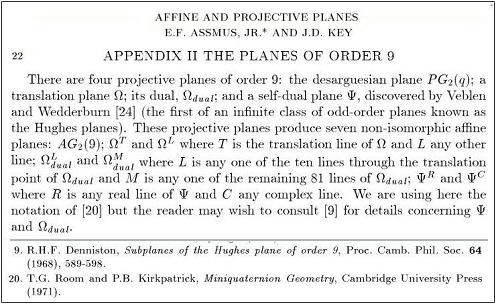
See also
Miniquaternion Geometry: The Four Projective Planes of Order 9 (pdf), by Katie Gorder (Dec. 5, 2003), and a book she cites:
Miniquaternion geometry: An introduction to the study of projective planes, by T. G. Room and P. B. Kirkpatrick. Cambridge Tracts in Mathematics and Mathematical Physics, No. 60. Cambridge University Press, London, 1971. viii+176 pp.
For “miniquaternions” of a different sort, see my entry on Visible Mathematics for Hamilton’s birthday last year:
Comments Off on Thursday January 26, 2006
Monday, January 23, 2006
In Defense of Hilbert
(On His Birthday)
Michael Harris (Log24, July 25 and 26, 2003) in a recent essay, Why Mathematics? You Might Ask (pdf), to appear in the forthcoming Princeton Companion to Mathematics:
“Mathematicians can… claim to be the first postmodernists: compare an art critic’s definition of postmodernism– ‘meaning is suspended in favor of a game involving free-floating signs’– with Hilbert’s definition of mathematics as ‘a game played according to certain simple rules with meaningless marks on paper.'”
Harris adds in a footnote:
“… the Hilbert quotation is easy to find but is probably apocryphal, which doesn’t make it any less significant.”
If the quotation is probably apocryphal, Harris should not have called it “Hilbert’s definition.”
For a much more scholarly approach to the concepts behind the alleged quotation, see Richard Zach, Hilbert’s Program Then and Now (pdf):
[Weyl, 1925] described Hilbert’s project as replacing meaningful mathematics by a meaningless game of formulas. He noted that Hilbert wanted to ‘secure not truth, but the consistency of analysis’ and suggested a criticism that echoes an earlier one by Frege: Why should we take consistency of a formal system of mathematics as a reason to believe in the truth of the pre-formal mathematics it codifies? Is Hilbert’s meaningless inventory of formulas not just ‘the bloodless ghost of analysis’?”
Some of Zach’s references:
[Ramsey, 1926] Frank P. Ramsey. Mathematical logic. The Mathematical Gazette, 13:185-94, 1926. Reprinted in [Ramsey, 1990, 225-244].
[Ramsey, 1990] Frank P. Ramsey. Philosophical Papers, D. H. Mellor, editor. Cambridge University Press, Cambridge, 1990
From Frank Plumpton Ramsey’s Philosophical Papers, as cited above, page 231:
“… I must say something of the system of Hilbert and his followers…. regarding higher mathematics as the manipulation of meaningless symbols according to fixed rules….
Mathematics proper is thus regarded as a sort of game, played with meaningless marks on paper rather like noughts and crosses; but besides this there will be another subject called metamathematics, which is not meaningless, but consists of real assertions about mathematics, telling us that this or that formula can or cannot be obtained from the axioms according to the rules of deduction….
Now, whatever else a mathematician is doing, he is certainly making marks on paper, and so this point of view consists of nothing but the truth; but it is hard to suppose it the whole truth.”
[Weyl, 1925] Hermann Weyl. Die heutige Erkenntnislage in der Mathematik. Symposion, 1:1-23, 1925. Reprinted in: [Weyl, 1968, 511-42]. English translation in: [Mancosu, 1998a, 123-42]….
[Weyl, 1968] Hermann Weyl. Gesammelte Abhandlungen, volume 1, K. Chandrasekharan, editor. Springer Verlag, Berlin, 1968.
[Mancosu, 1998a] Paolo Mancosu, editor. From Brouwer to Hilbert. The Debate on the Foundations of Mathematics in the 1920s. Oxford University Press, Oxford, 1998.
From Hermann Weyl, “Section V: Hilbert’s Symbolic Mathematics,” in Weyl’s “The Current Epistemogical Situation in Mathematics,” pp. 123-142 in Mancosu, op. cit.:
“What Hilbert wants to secure is not the truth, but the consistency of the old analysis. This would, at least, explain that historic phenomenon of the unanimity amongst all the workers in the vineyard of analysis.
To furnish the consistency proof, he has first of all to formalize mathematics. In the same way in which the contentual meaning of concepts such as “point, plane, between,” etc. in real space was unimportant in geometrical axiomatics in which all interest was focused on the logical connection of the geometrical concepts and statements, one must eliminate here even more thoroughly any meaning, even the purely logical one. The statements become meaningless figures built up from signs. Mathematics is no longer knowledge but a game of formulae, ruled by certain conventions, which is very well comparable to the game of chess. Corresponding to the chess pieces we have a limited stock of signs in mathematics, and an arbitrary configuration of the pieces on the board corresponds to the composition of a formula out of the signs. One or a few formulae are taken to be axioms; their counterpart is the prescribed configuration of the pieces at the beginning of a game of chess. And in the same way in which here a configuration occurring in a game is transformed into the next one by making a move that must satisfy the rules of the game, there, formal rules of inference hold according to which new formulae can be gained, or ‘deduced,’ from formulae. By a game-conforming [spielgerecht] configuration in chess I understand a configuration that is the result of a match played from the initial position according to the rules of the game. The analogue in mathematics is the provable (or, better, the proven) formula, which follows from the axioms on grounds of the inference rules. Certain formulae of intuitively specified character are branded as contradictions; in chess we understand by contradictions, say, every configuration which there are 10 queens of the same color. Formulae of a different structure tempt players of mathematics, in the way checkmate configurations tempt chess players, to try to obtain them through clever combination of moves as the end formula of a correctly played proof game. Up to this point everything is a game; nothing is knowledge; yet, to use Hilbert’s terminology, in ‘metamathematics,’ this game now becomes the object of knowledge. What is meant to be recognized is that a contradiction can never occur as an end formula of a proof. Analogously it is no longer a game, but knowledge, if one shows that in chess, 10 queens of one color cannot occur in a game-conforming configuration. One can see this in the following way: The rules are teaching us that a move can never increase the sum of the number of queens and pawns of one color. In the beginning this sum = 9, and thus– here we carry out an intuitively finite [anschaulich-finit] inference through complete induction– it cannot be more than this value in any configuration of a game. It is only to gain this one piece of knowledge that Hilbert requires contentual and meaningful thought; his proof of consistency proceeds quite analogously to the one just carried out for chess, although it is, obviously, much more complicated.
It follows from our account that mathematics and logic must be formalized together. Mathematical logic, much scorned by philosophers, plays an indispensable role in this context.”
Constance Reid says it was not Hilbert himself, but his critics, who described Hilbert’s formalism as reducing mathematics to “a meaningless game,” and quotes the Platonist Hardy as saying that Hilbert was ultimately concerned not with meaningless marks on paper, but with ideas:
“Hilbert’s program… received its share of criticism. Some mathematicians objected that in his formalism he had reduced their science to ‘a meaningless game played with meaningless marks on paper.’ But to those familiar with Hilbert’s work this criticism did not seem valid.
‘… is it really credible that this is a fair account of Hilbert’s view,’ Hardy demanded, ‘the view of the man who has probably added to the structure of significant mathematics a richer and more beautiful aggregate of theorems than any other mathematician of his time? I can believe that Hilbert’s philosophy is as inadequate as you please, but not that an ambitious mathematical theory which he has elaborated is trivial or ridiculous. It is impossible to suppose that Hilbert denies the significance and reality of mathematical concepts, and we have the best of reasons for refusing to believe it: “The axioms and demonstrable theorems,” he says himself, “which arise in our formalistic game, are the images of the ideas which form the subject-matter of ordinary mathematics.”‘”
— Constance Reid in Hilbert-Courant, Springer-Verlag, 1986 (The Hardy passage is from “Mathematical Proof,” Mind 38, 1-25, 1929, reprinted in Ewald, From Kant to Hilbert.)
Harris concludes his essay with a footnote giving an unsourced Weyl quotation he found on a web page of David Corfield:
“.. we find ourselves in [mathematics] at exactly that crossing point of constraint and freedom which is the very essence of man’s nature.”
One source for the Weyl quotation is the above-cited book edited by Mancosu, page 136. The quotation in the English translation given there:
“Mathematics is not the rigid and petrifying schema, as the layman so much likes to view it; with it, we rather stand precisely at the point of intersection of restraint and freedom that makes up the essence of man itself.”
Corfield says of this quotation that he’d love to be told the original German. He should consult the above references cited by Richard Zach.
For more on the intersection of restraint and freedom and the essence of man’s nature, see the Kierkegaard chapter cited in the previous entry.
Comments Off on Monday January 23, 2006
Friday, January 20, 2006
Fourstone Parable
"Wherefore let it hardly… be… thought that the prisoner… was at his best a onestone parable…
for… pathetically few… cared… to doubt… the canonicity of his existence as a tesseract."
— Finnegans Wake, page 100, abridged
"… we have forgotten that we were angels and painted ourselves into a corner
of resource extraction and commodification of ourselves."
— A discussion, in a draft of a paper (rtf) attributed to Josh Schultz,
of the poem "Diamond" by Attila Jozsef
Commodification of
the name Cullinane:
See the logos at
cullinane.com,
a design firm with
the motto

(Note the 4Cs theme.)
To adapt a phrase from
Finnegans Wake, the
"fourstone parable" below
is an attempt to
decommodify my name.
Fourstone Parable:
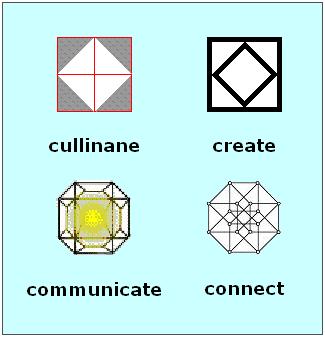
(See also yesterday's "Logos."
The "communicate" logo is taken from
an online library at Calvin College;
the "connect" logo is a commonly
available picture of a tesseract
(Coxeter, Regular Polytopes, p. 123),
and the other two logos
are more or less original.)
For a more elegant
four-diamond figure, see
Jung and the Imago Dei.
Comments Off on Friday January 20, 2006
Sunday, January 15, 2006
Inscape
My entry for New Year's Day links to a paper by Robert T. Curtis*
from The Arabian Journal for Science and Engineering
(King Fahd University, Dhahran, Saudi Arabia),
Volume 27, Number 1A, January 2002.
From that paper:
"Combinatorially, an outer automorphism [of S6] can exist because the number of unordered pairs of 6 letters is equal to the number of ways in which 6 letters can be partitioned into three pairs. Which is to say that the two conjugacy classes of odd permutations of order 2 in S6 contain the same number of elements, namely 15. Sylvester… refers to the unordered pairs as duads and the partitions as synthemes. Certain collections of five synthemes… he refers to as synthematic totals or simply totals; each total is stabilized within S6 by a subgroup acting triply transitively on the 6 letters as PGL2(5) acts on the projective line. If we draw a bipartite graph on (15+15) vertices by joining each syntheme to the three duads it contains, we obtain the famous 8-cage (a graph of valence 3 with minimal cycles of length 8)…."
Here is a way of picturing the 8-cage and a related configuration of points and lines:
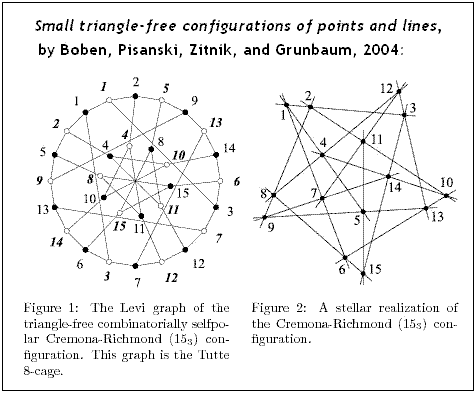
Diamond Theory shows that this structure
can also be modeled by an "inscape"
made up of subsets of a
4×4 square array:
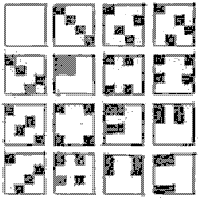
The illustration below shows how the
points and lines of the inscape may
be identified with those of the
Cremona-Richmond configuration.

* "A fresh approach to the exceptional automorphism and covers of the symmetric groups"
Comments Off on Sunday January 15, 2006
« Newer Posts —
Older Posts »





























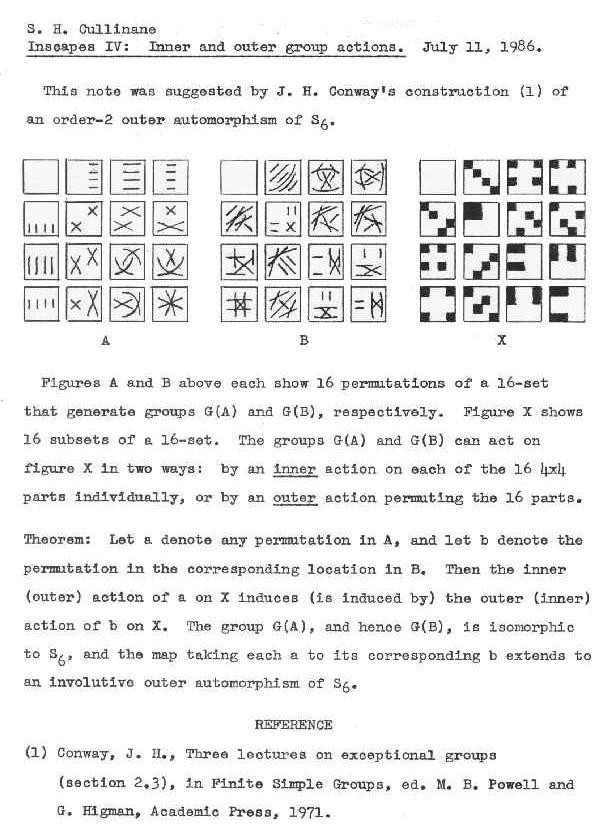
















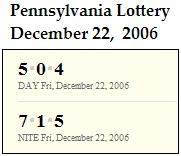


















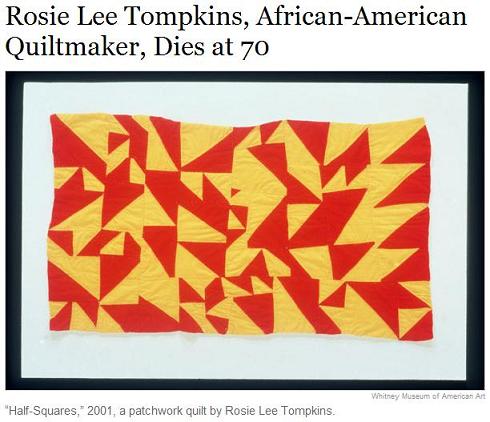








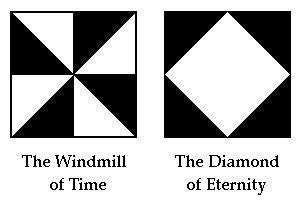















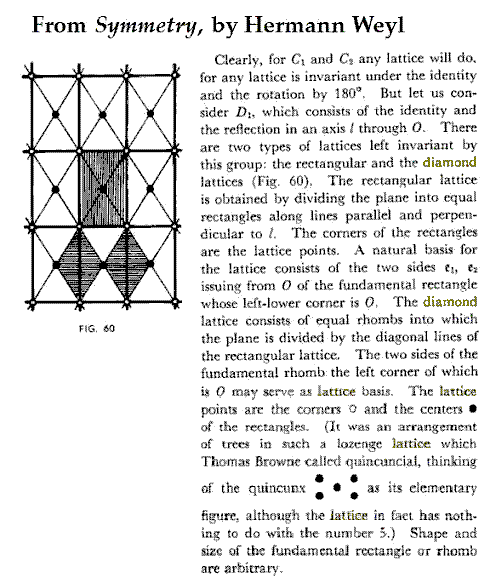









































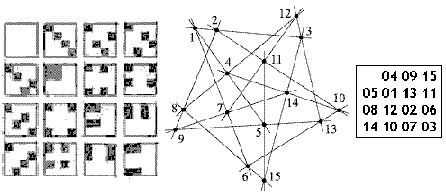































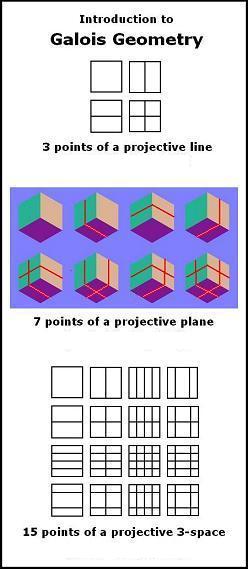











 doesn’t change, even if the idea one has about it may change.’ ( p. 263). This claim, referring to a ‘crescendo of absurdity’ in Sokal’s original hoax in Social Text, is criticized by anthropologist Joan Fujimura, in an article translated for IS*. Most of Fujimura’s article consists of an astonishingly bland account of the history of non-euclidean geometry, in which she points out that the ratio of the circumference to the diameter depends on the metric. Sokal and Bricmont know this, and Fujimura’s remarks are about as helpful as FN’s** referral of Quine’s readers to Hume (p. 70). Anyway, Sokal explicitly referred to “Euclid’s pi”, presumably to avoid trivial objections like Fujimura’s — wasted effort on both sides.32 If one insists on making trivial objections, one might recall that the theorem
doesn’t change, even if the idea one has about it may change.’ ( p. 263). This claim, referring to a ‘crescendo of absurdity’ in Sokal’s original hoax in Social Text, is criticized by anthropologist Joan Fujimura, in an article translated for IS*. Most of Fujimura’s article consists of an astonishingly bland account of the history of non-euclidean geometry, in which she points out that the ratio of the circumference to the diameter depends on the metric. Sokal and Bricmont know this, and Fujimura’s remarks are about as helpful as FN’s** referral of Quine’s readers to Hume (p. 70). Anyway, Sokal explicitly referred to “Euclid’s pi”, presumably to avoid trivial objections like Fujimura’s — wasted effort on both sides.32 If one insists on making trivial objections, one might recall that the theorem












